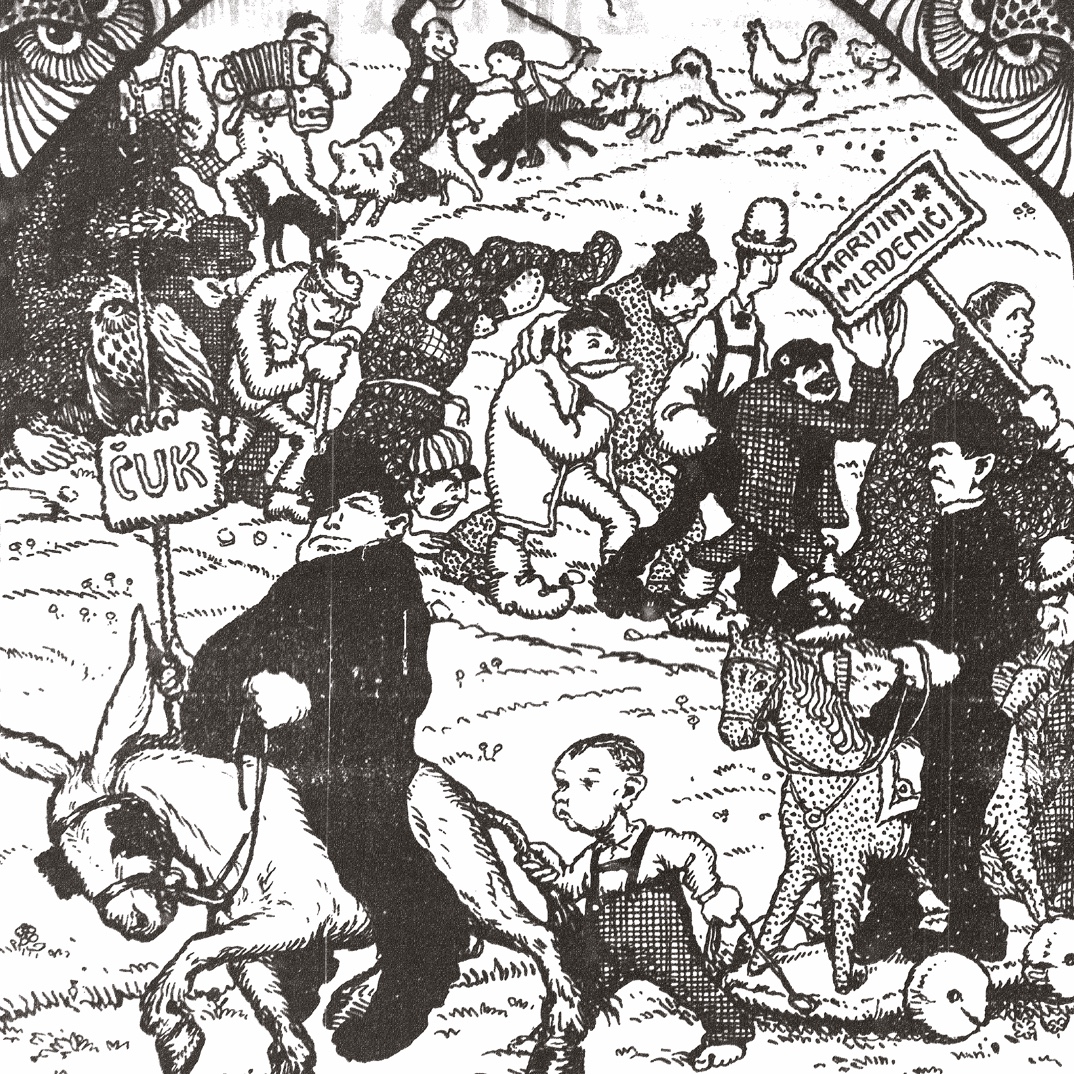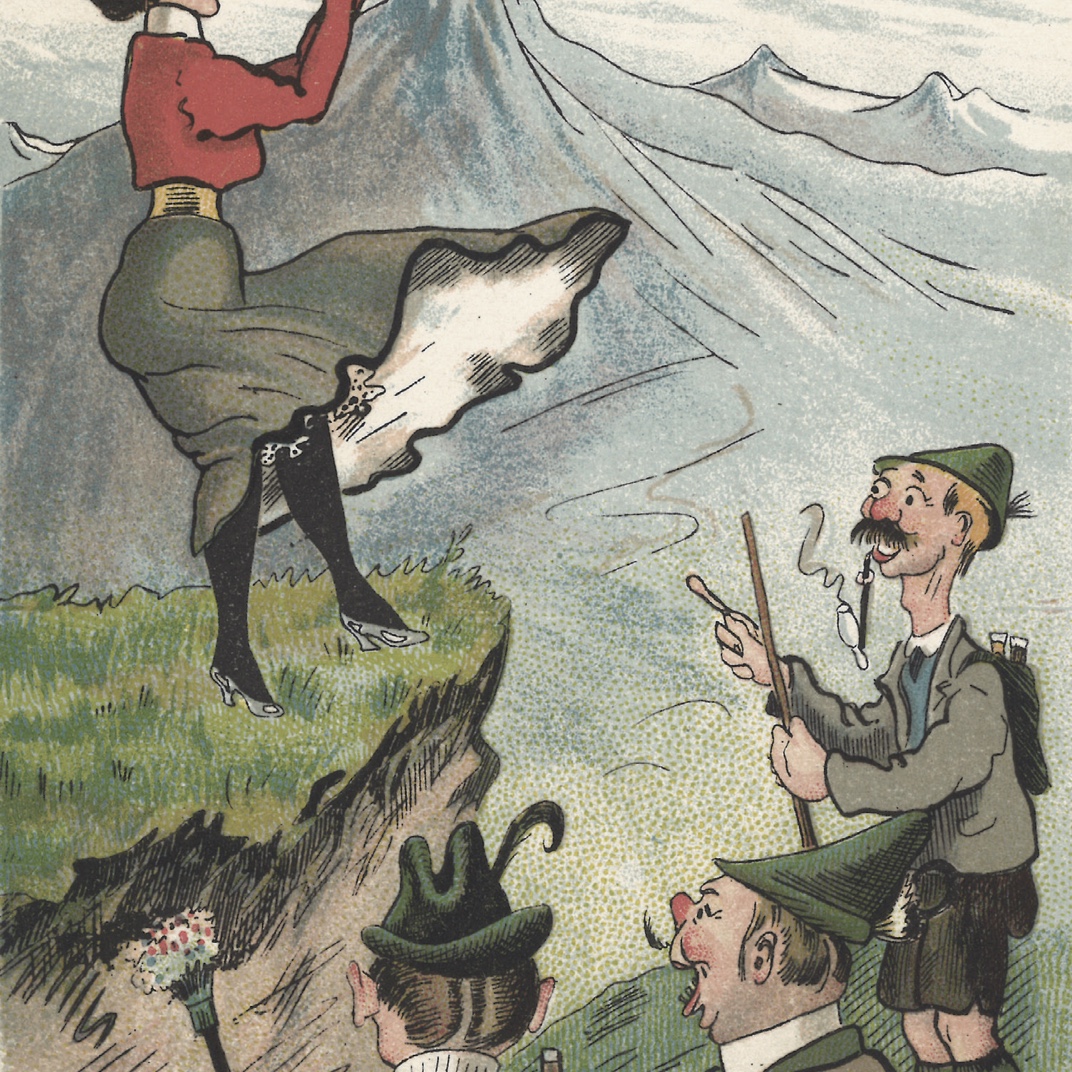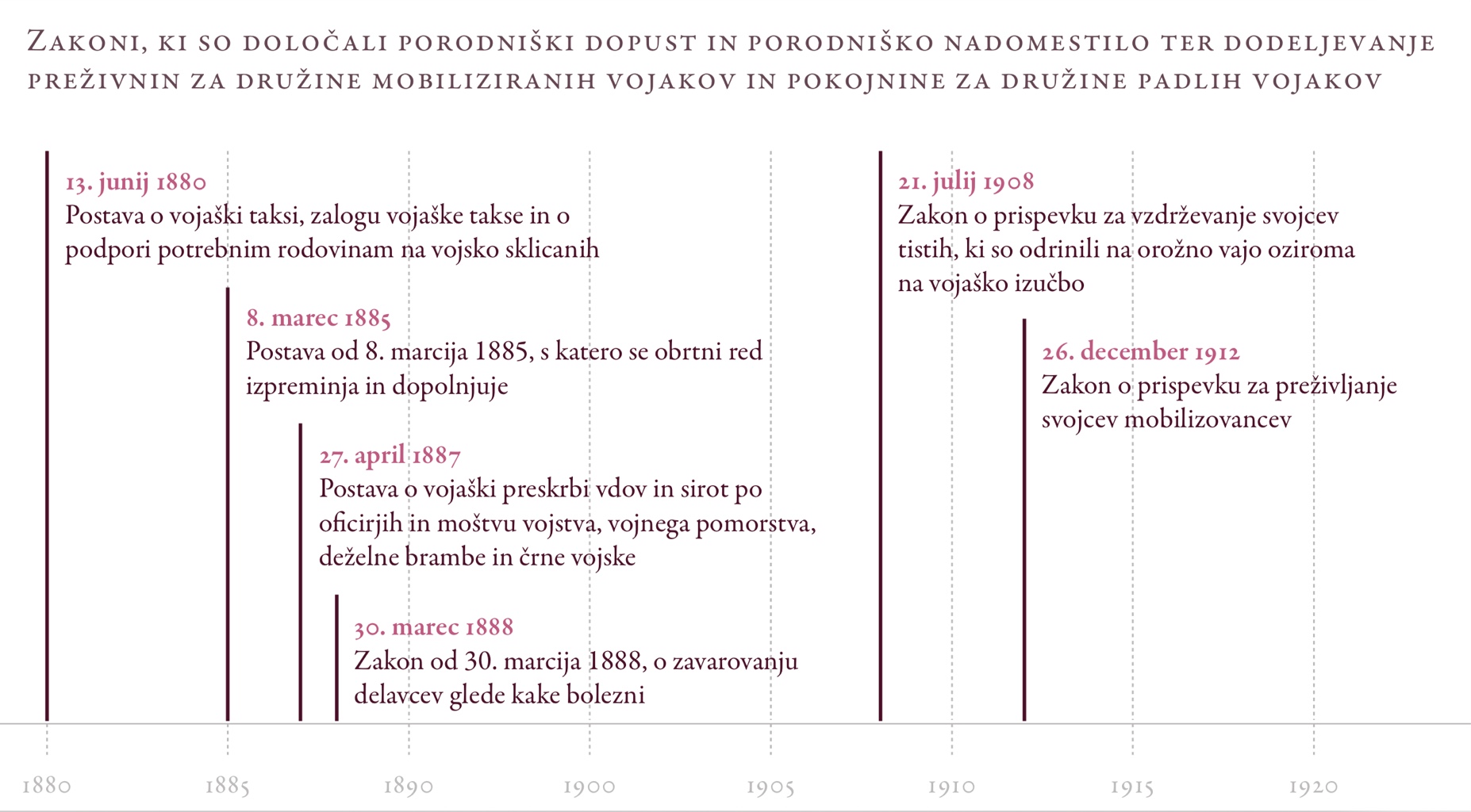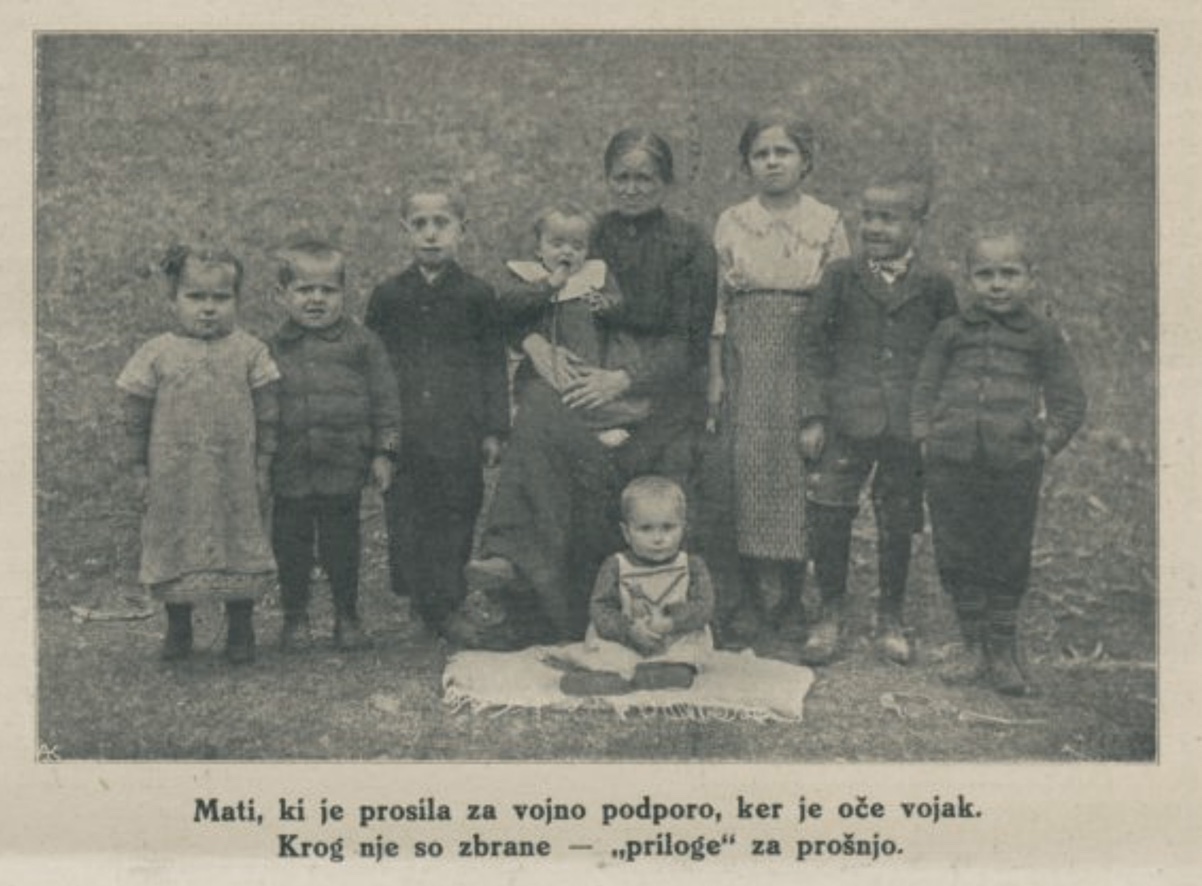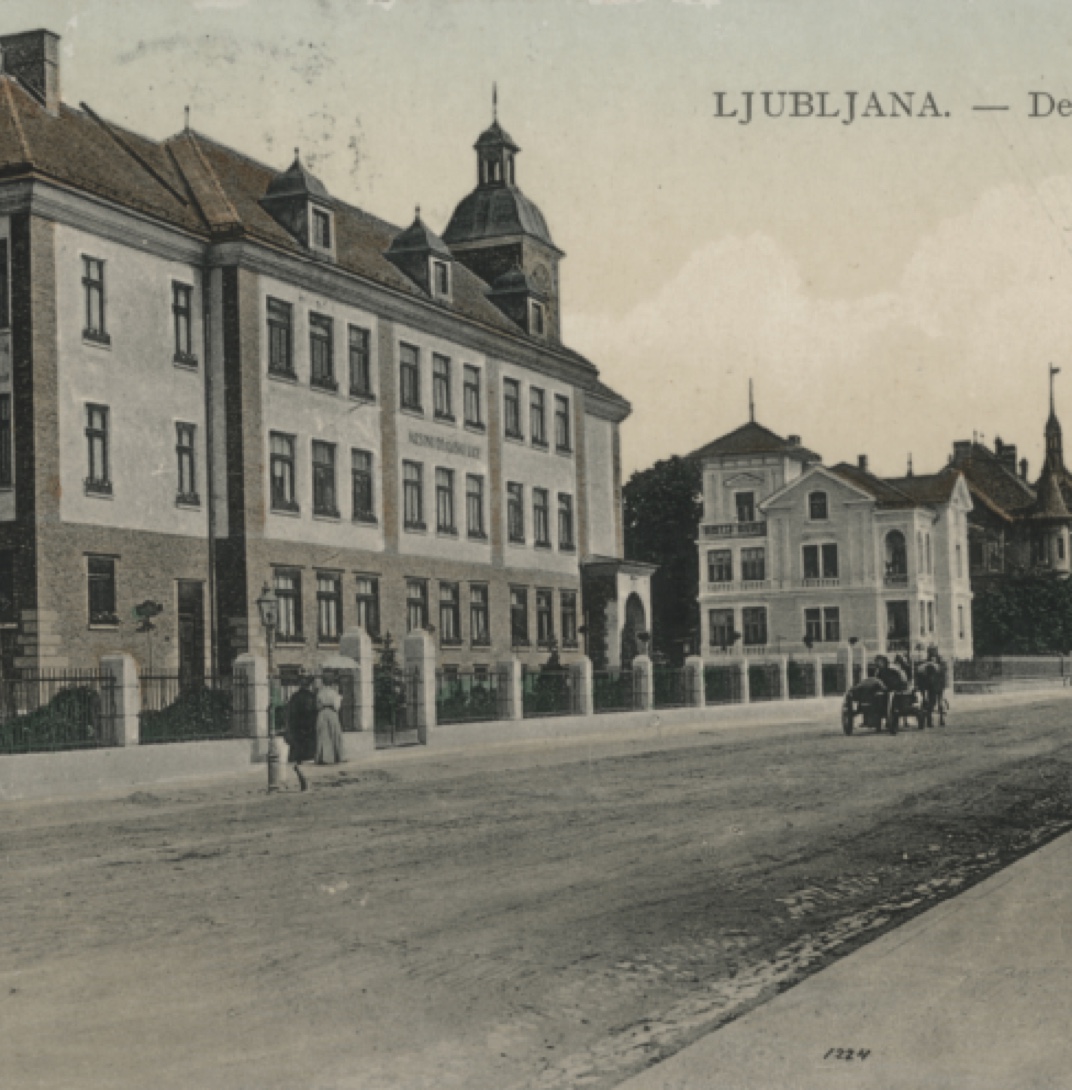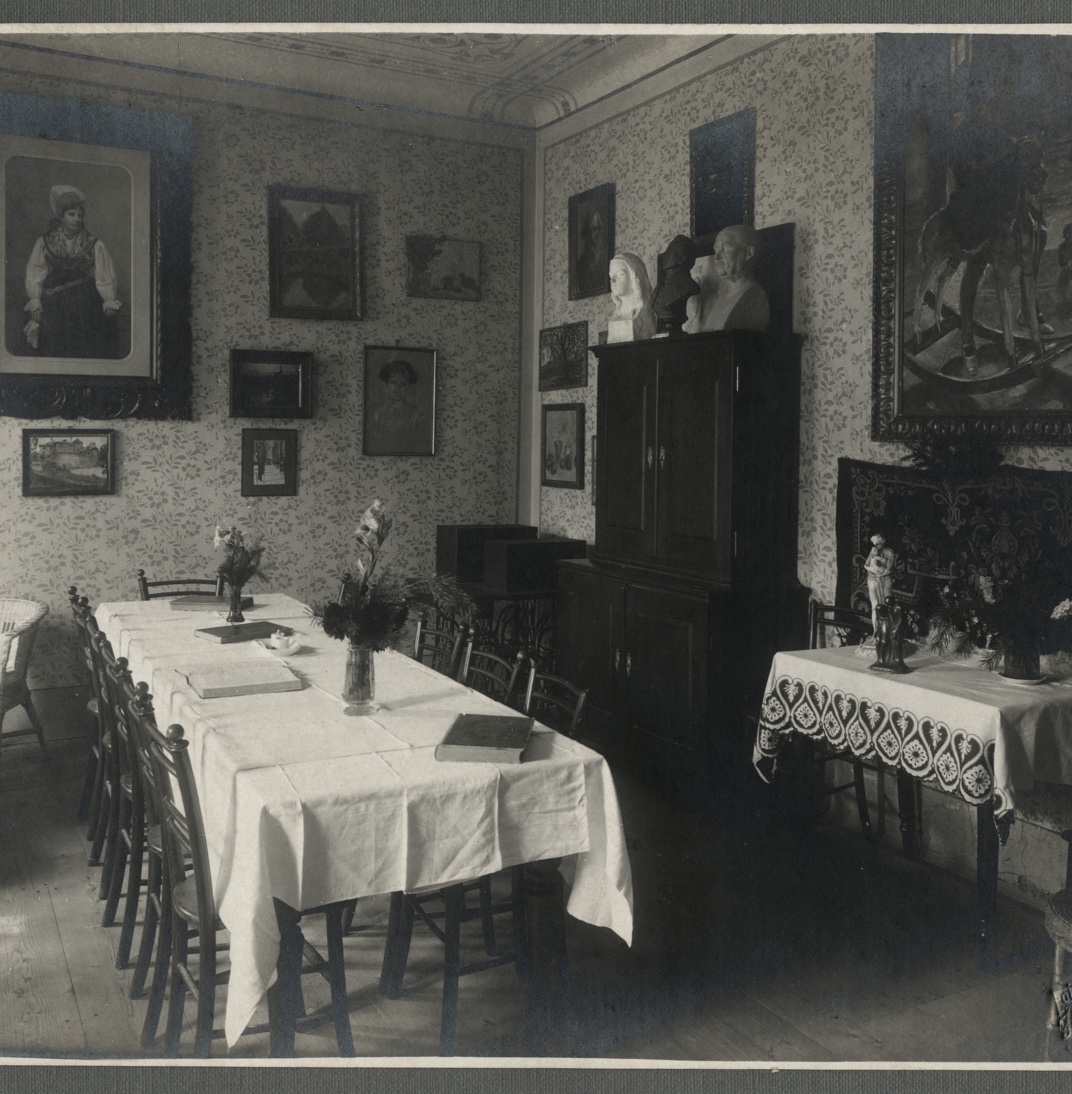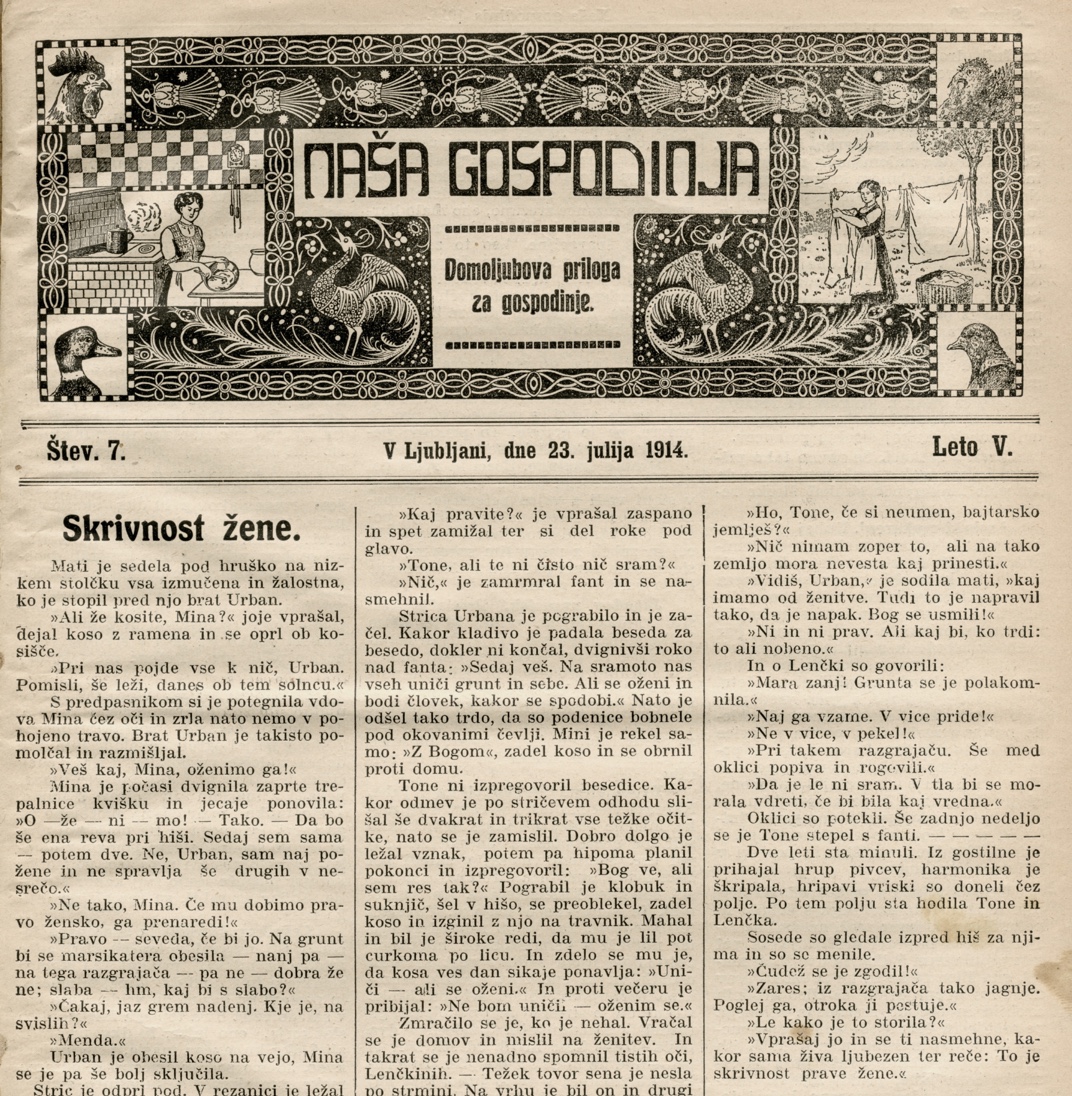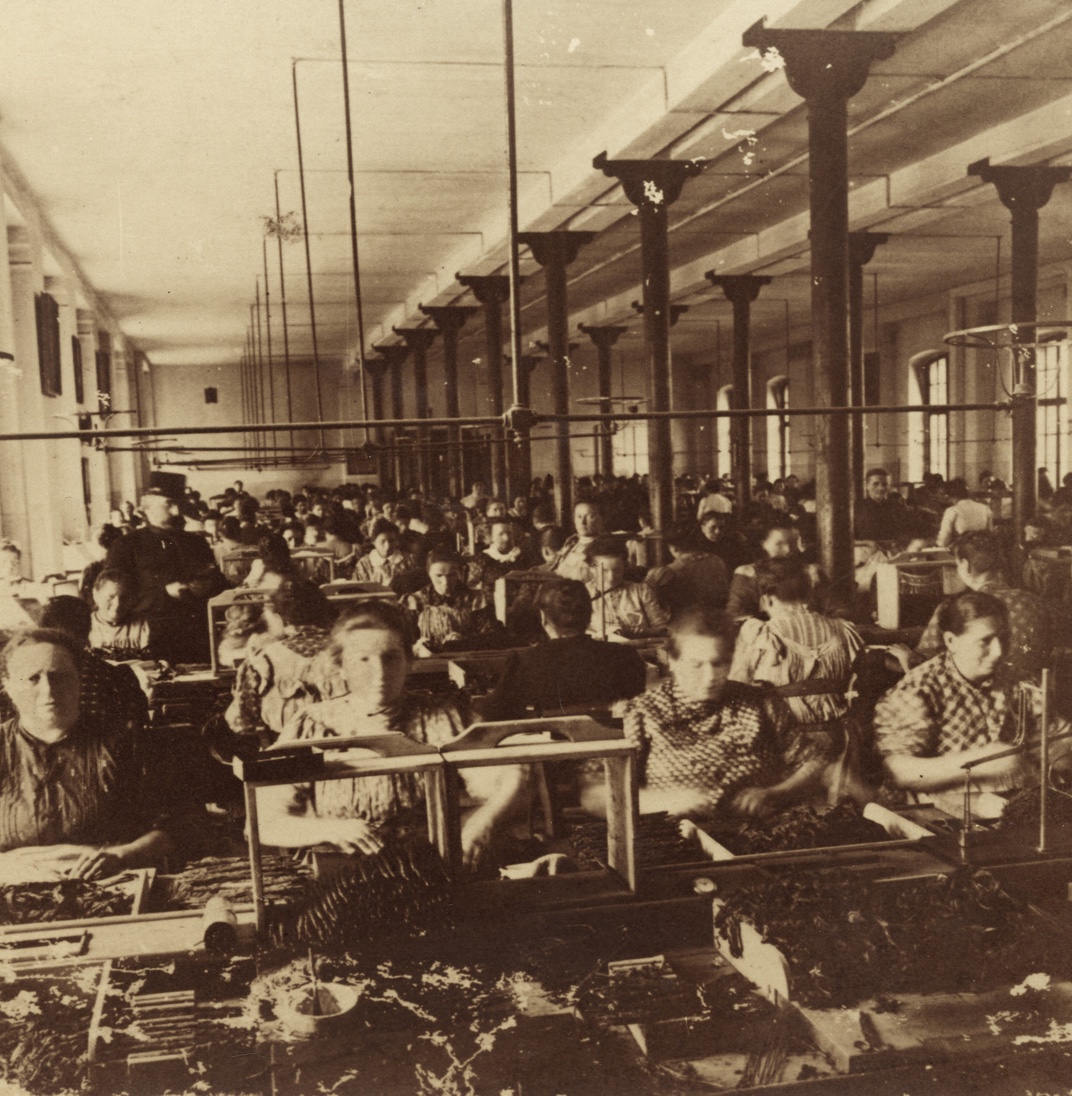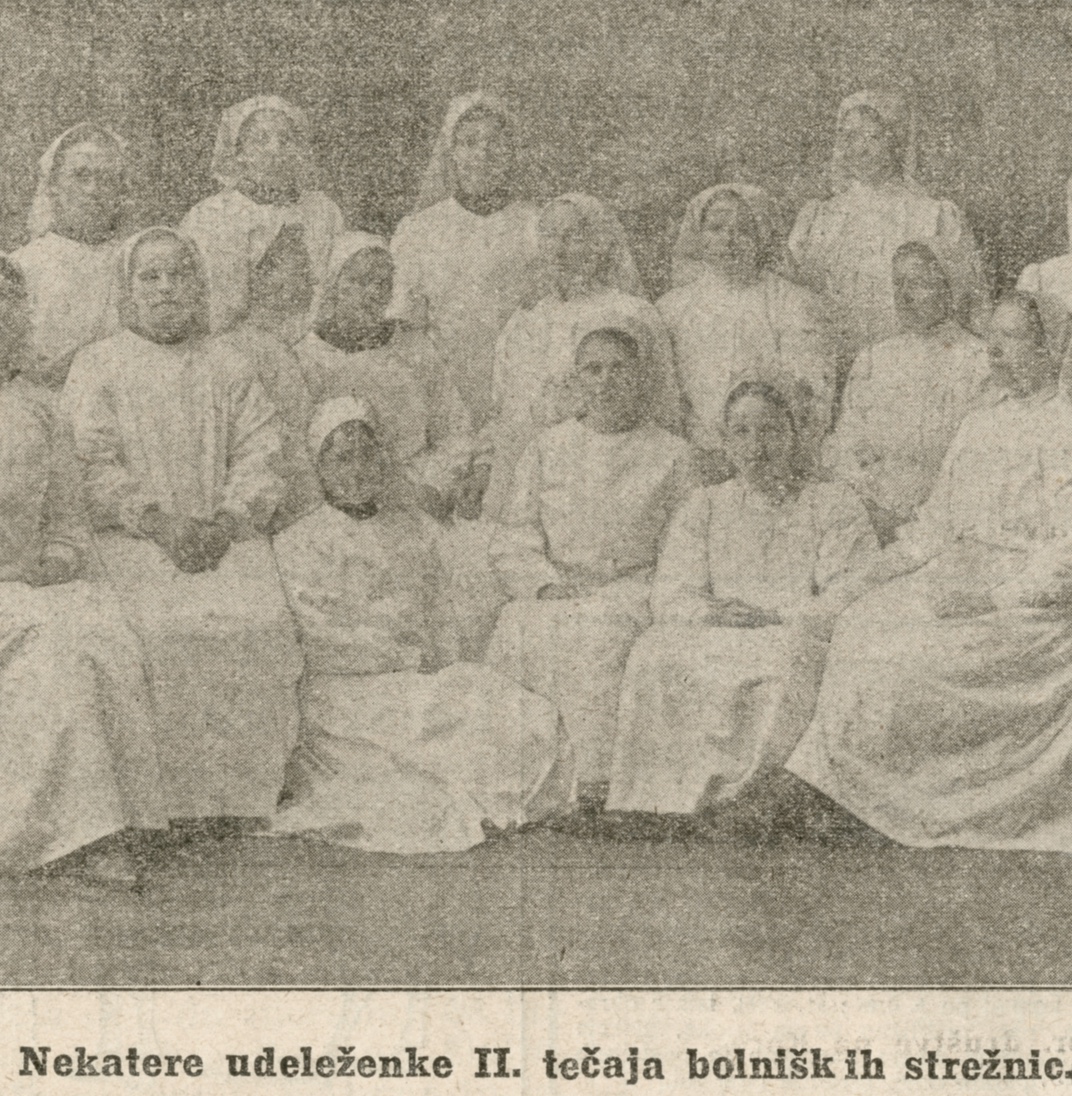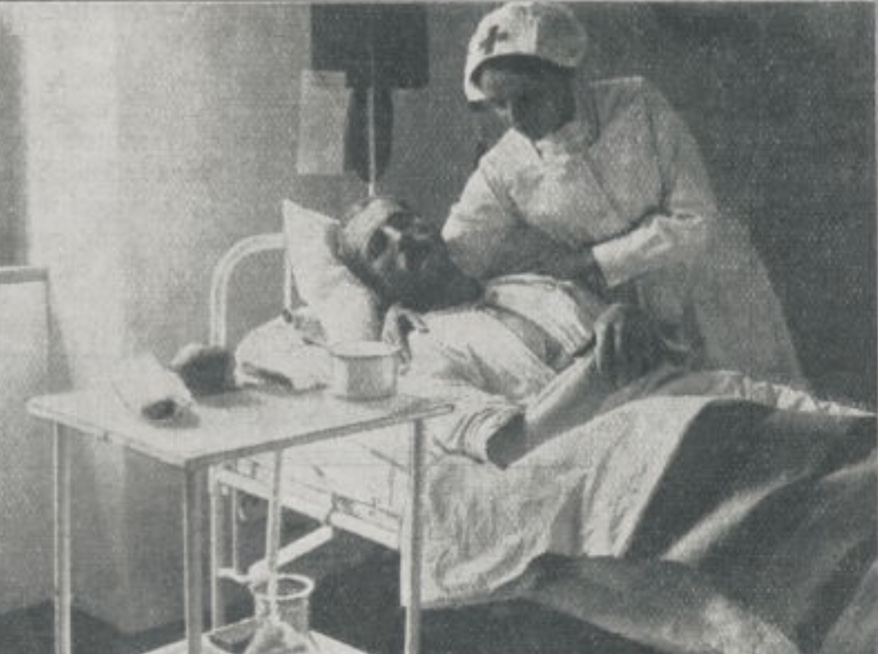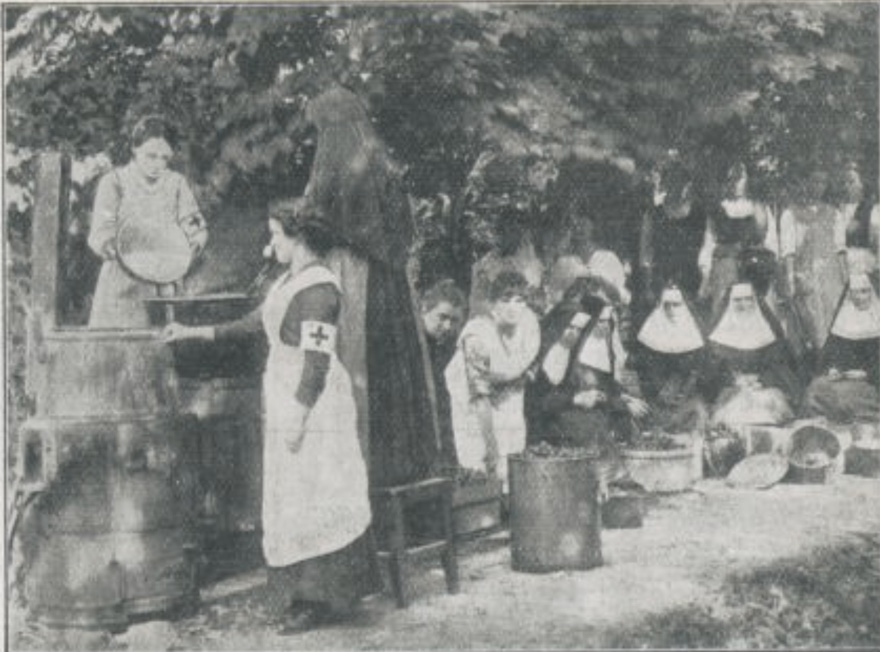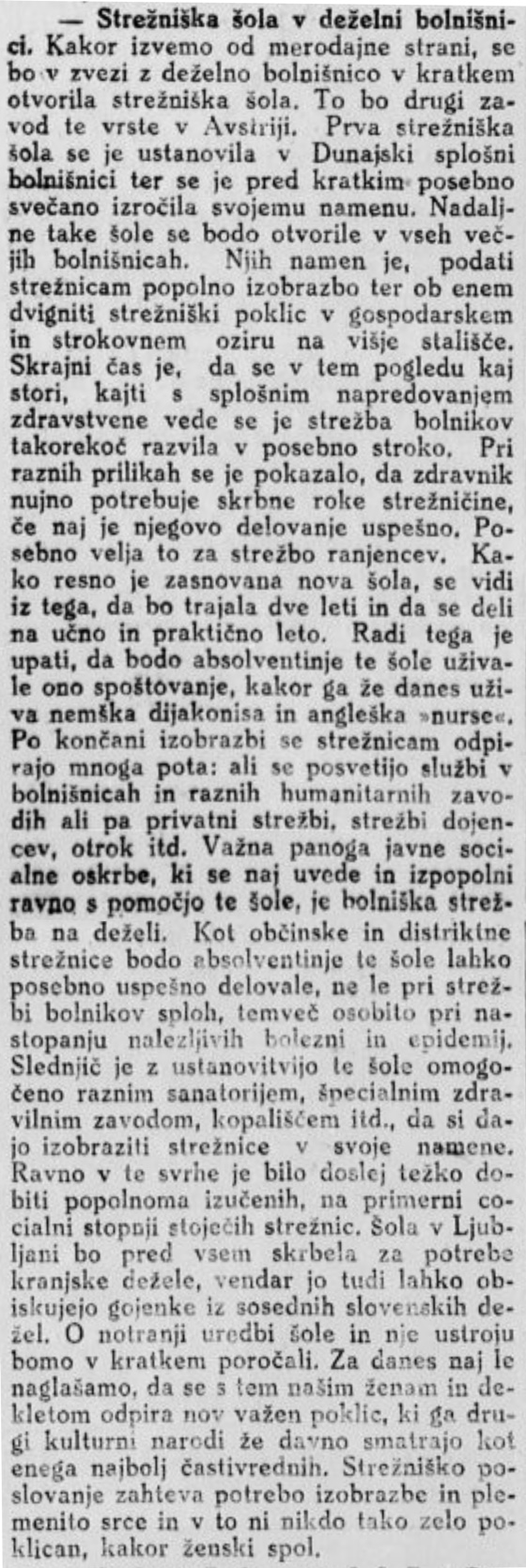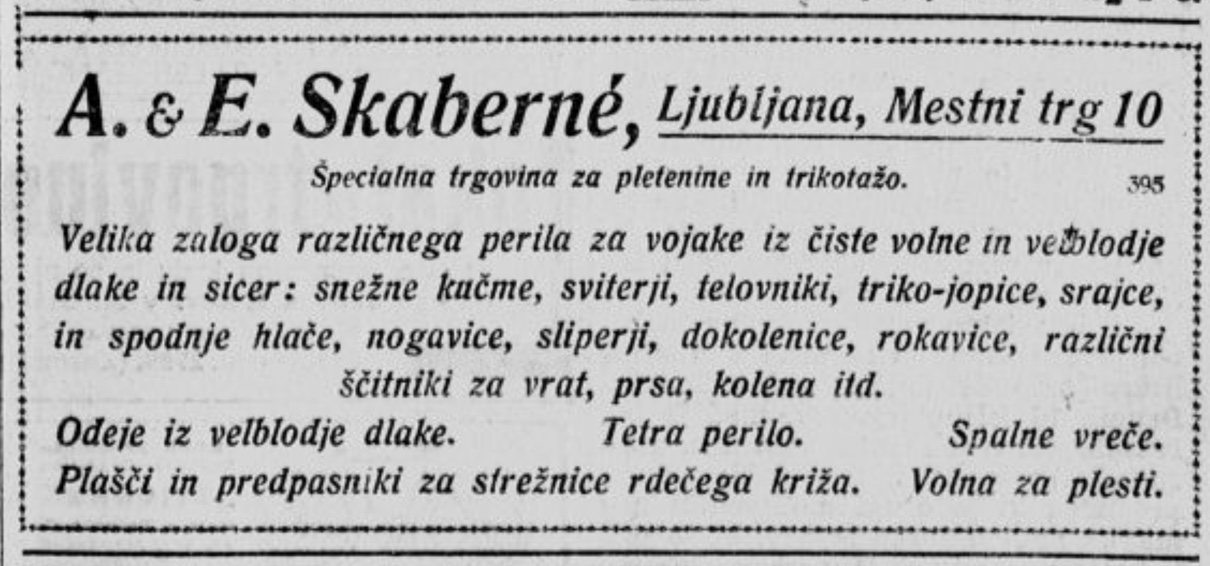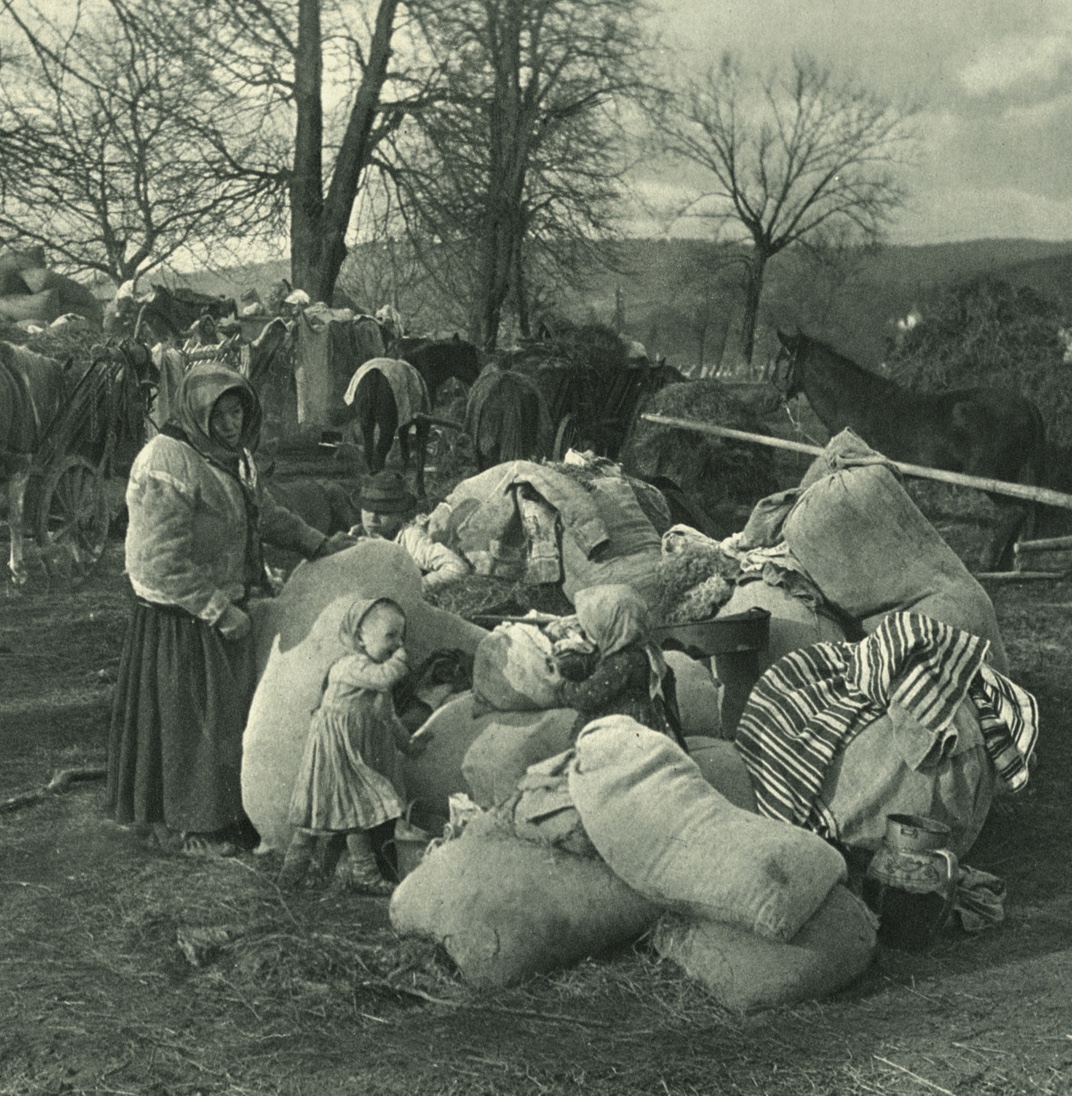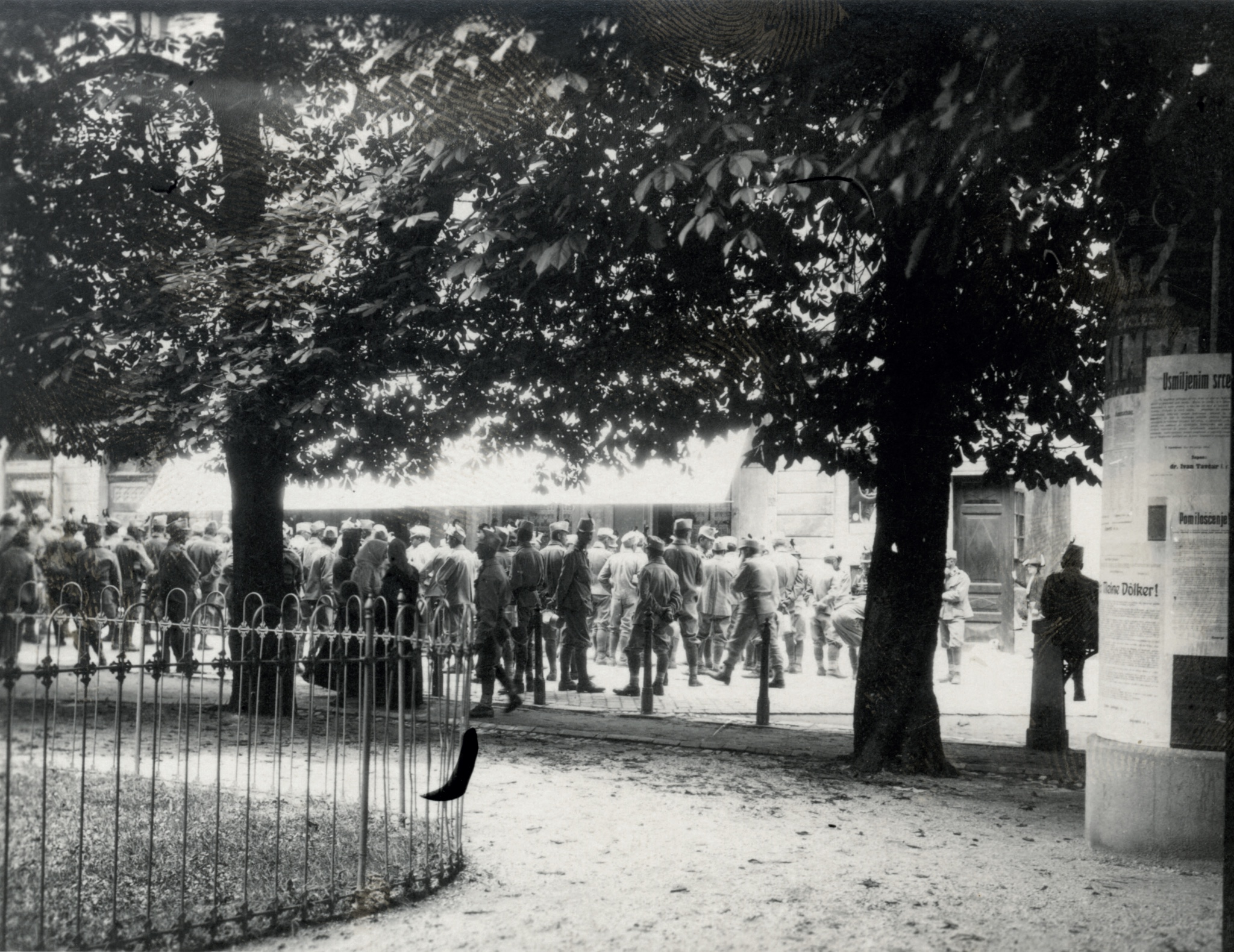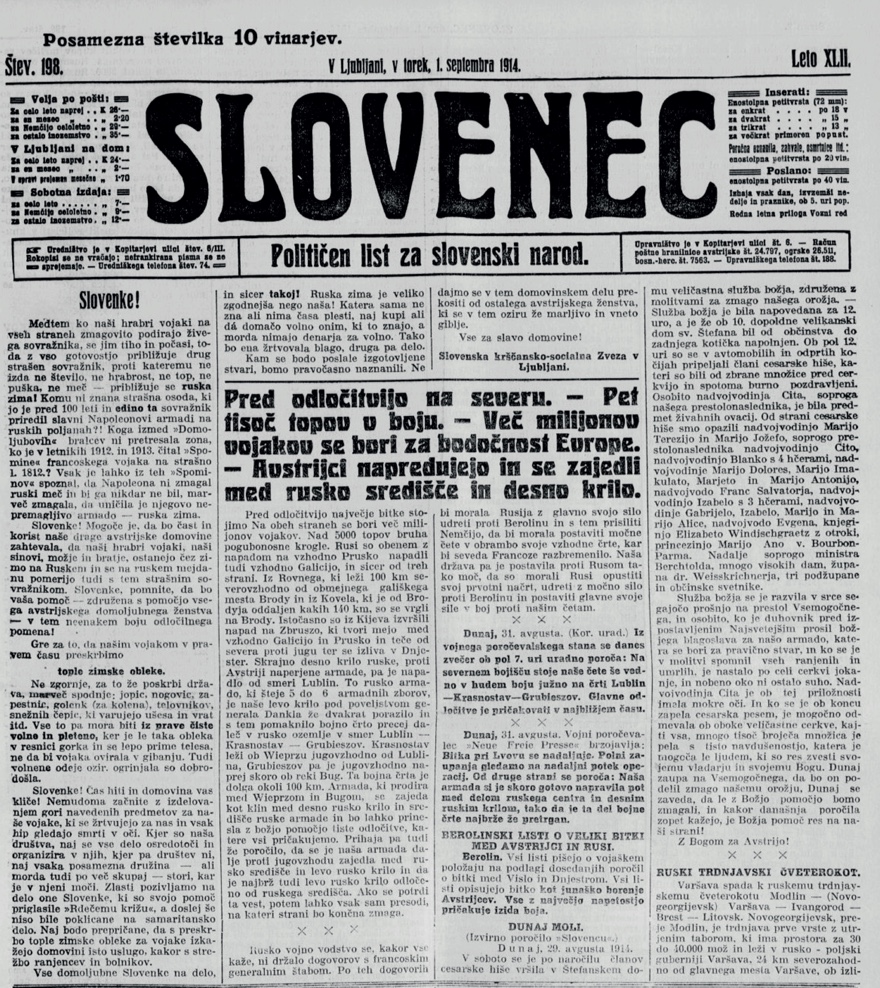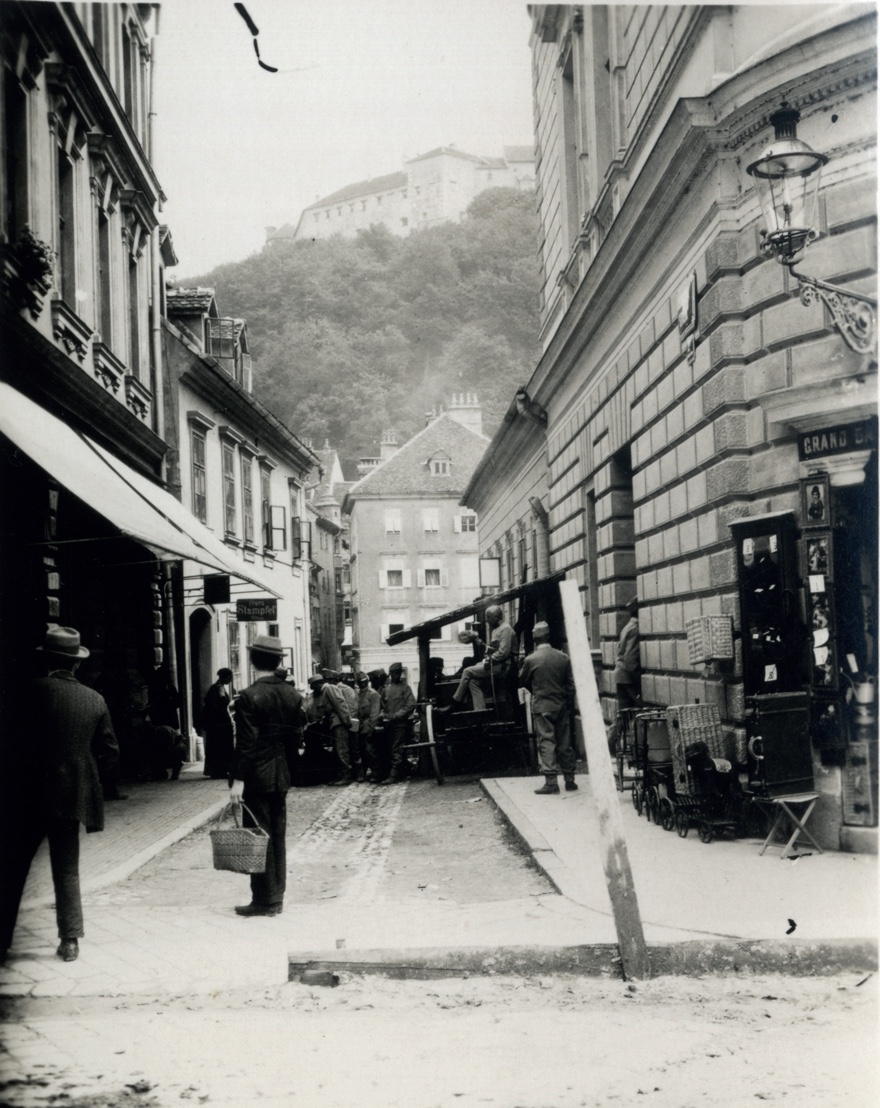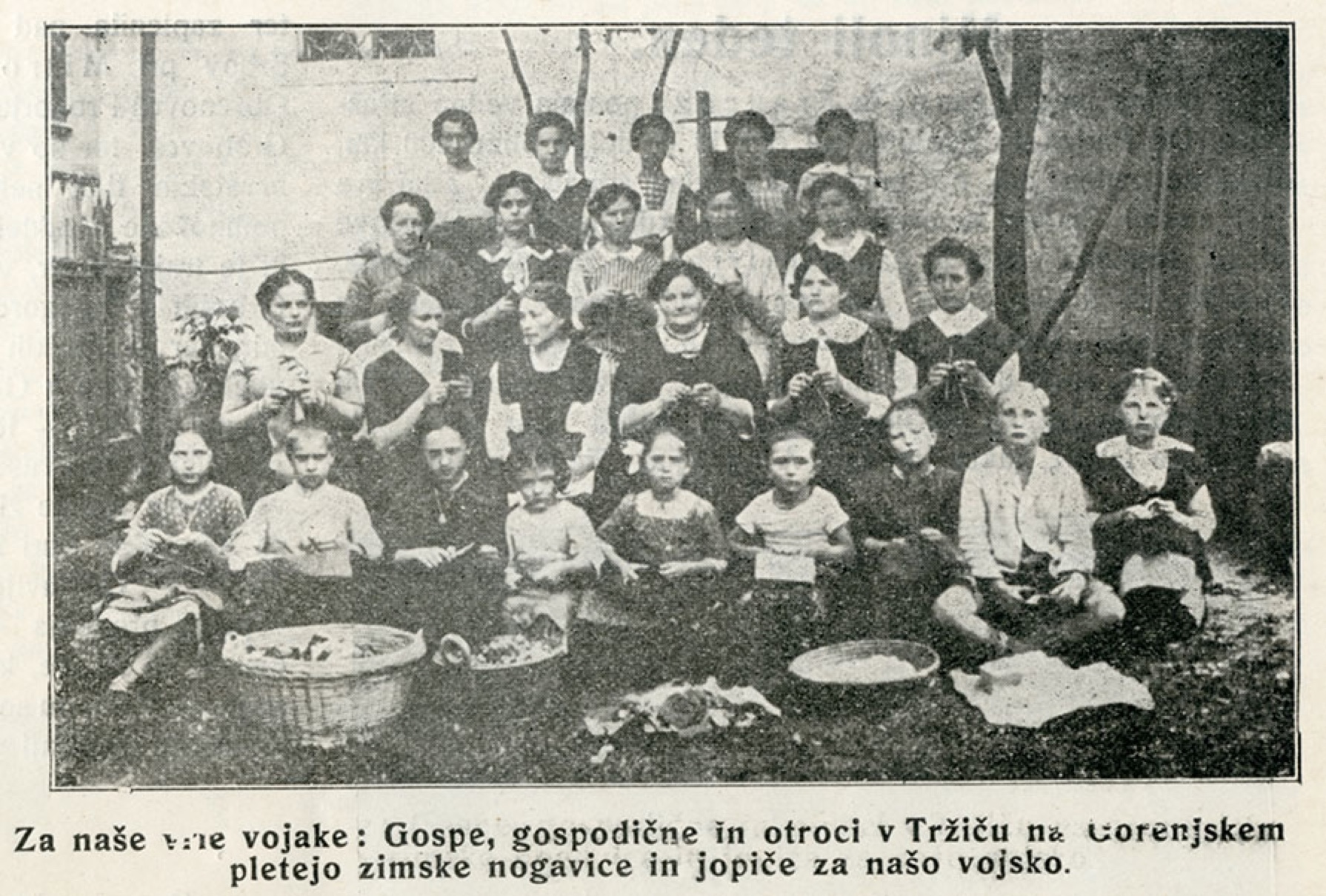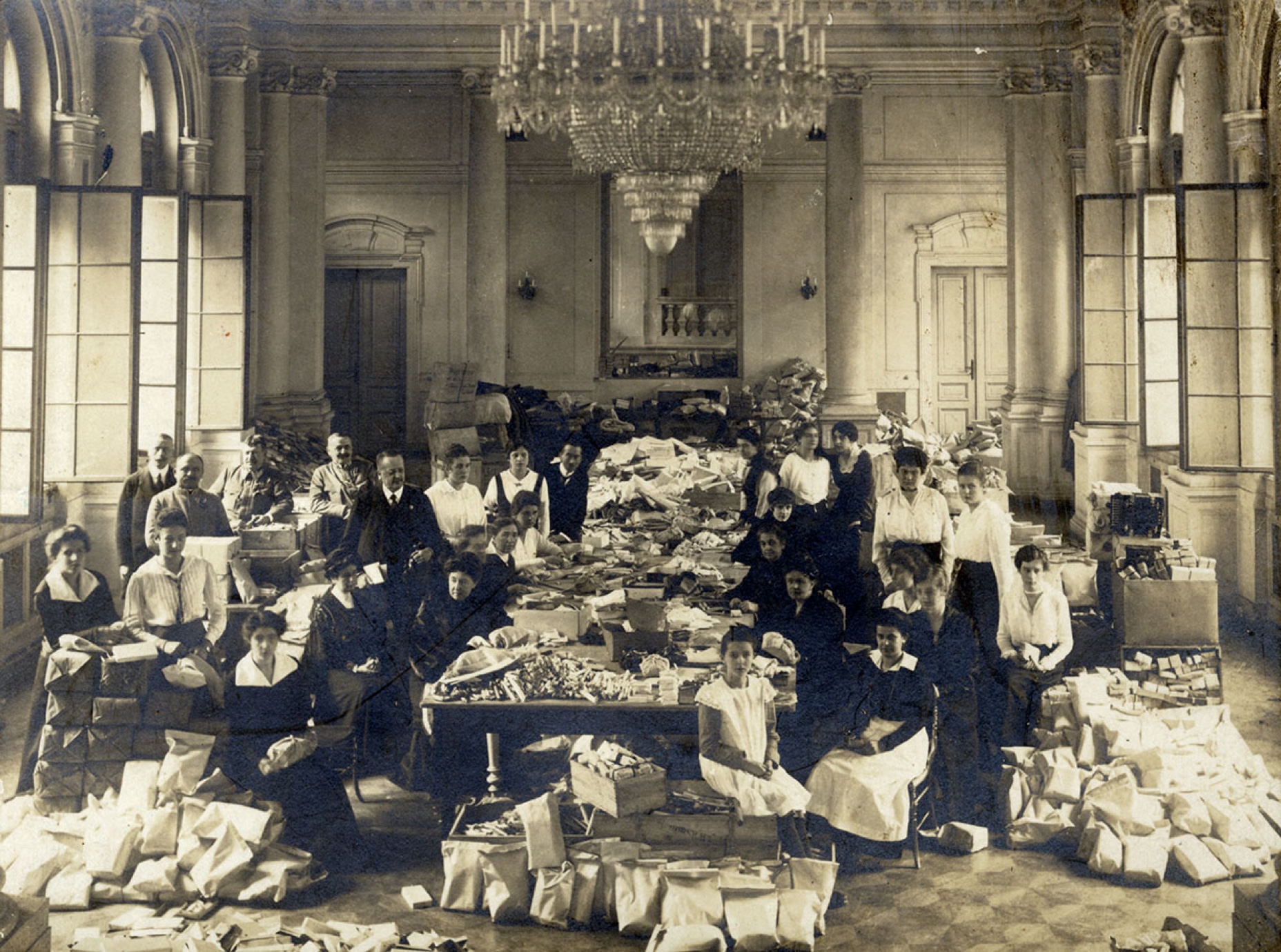
The Position of Women on the Eve of the War
The pre-World War I period was one of modernization and gradual democratization. In a society that was taking over bourgeois patterns and values, women became a constituent part of the nation. Socially and culturally, their activities were growing in importance. The number of educated and trained women increased throughout Europe. The struggle for women’s emancipation and right to vote was spreading from the elite milieu of British suffragettes to mainland Europe and reached also Slovene lands.
The outbreak of the war after the assassination of Franz Ferdinand, heir to the Austrian throne, shook the very foundations of the then society. The war, initially believed that it would be of short duration, was due to its omnipresence and range soon considered to be a general one. Its destruction reached far into the fronts’ hinterland, where the war’s material and non-material consequences were beginning to manifest themselves. Millions of women, including those living in the territory of the present-day Republic of Slovenia, were faced with consequences of the general mobilization of men fit for military service, which was in Austria-Hungary announced on 31 July 1914. In the wake of men’s mass departure for the battlefields, women took over new responsibilities and tasks in their familial, professional, and public environment. As mothers and daughters they had to come up with new livelihoods outside the home or take up the management of family businesses or farms. In the immediate proximity of the battlefields, they retreated as refugees alongside the elderly and the children to safer locations within the monarchy. Away from the battlefields, they were active as war agitators, fervent supporters of the army, but also as spies, protesters, and, most of all, as charitable ladies.
Legislature
In 1811, the Allgemeines bürgerliches Gesetzbuch (Civil Code) introduced new provisions which decidedly marked the position of women particularly within the family and marriage. The Civil Code regulated their inferiority and dependence on their fathers or husbands. The majority of its provisions was in force up to the end of World War II. Even though the Austrian Civil Code laid the foundations of the traditional and patriarchal society, it was more favourably disposed towards the rights of women in courts of law, inter alia, also towards the rights of mothers of illegitimate children than the French Code Civil (1804).
Before the outbreak of World War I women’s suffrage was regulated by numerous laws that defined it in terms of parliamentary elections in Vienna, provincial diets, and local communities. At the turn of the 20th century women tax payers were only allowed to vote in city council elections. Women landowners were also entitled to vote in the Carniolan provincial diet. They voted by proxy, for the law stipulated that only men were allowed to cast votes. Women taxpayers and teachers were given the right to vote in the city council elections in Ljubljana in 1911.

Prikaz razvoja volilne pravice za Kranjsko. Volilna pravica je bila zlasti v začetku vezana na volilne razrede, kurije, v katere so bili volivci razvrščeni glede na okraj in stanovske interese (obstajale so mestna, kmečka, obrtno-trgovska in veleposestniška).

Rezultati občinskih volitev v Ljubljani leta 1911 so pokazali, da so volivke v primerjavi z drugimi ljubljanskimi (moškimi) volišči nadpovprečno podprle Slovensko ljudsko stranko.
Legenda: SLS – Slovenska ljudska stranka • NNS – Narodno napredna stranka • JSDS – Jugoslovanska socialdemokratska stranka
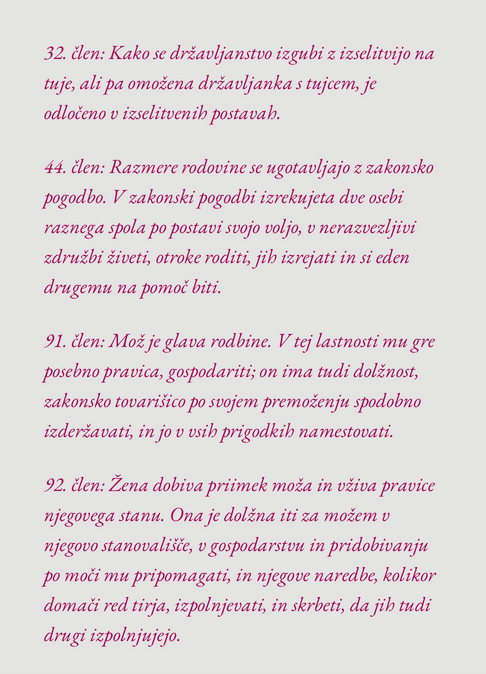
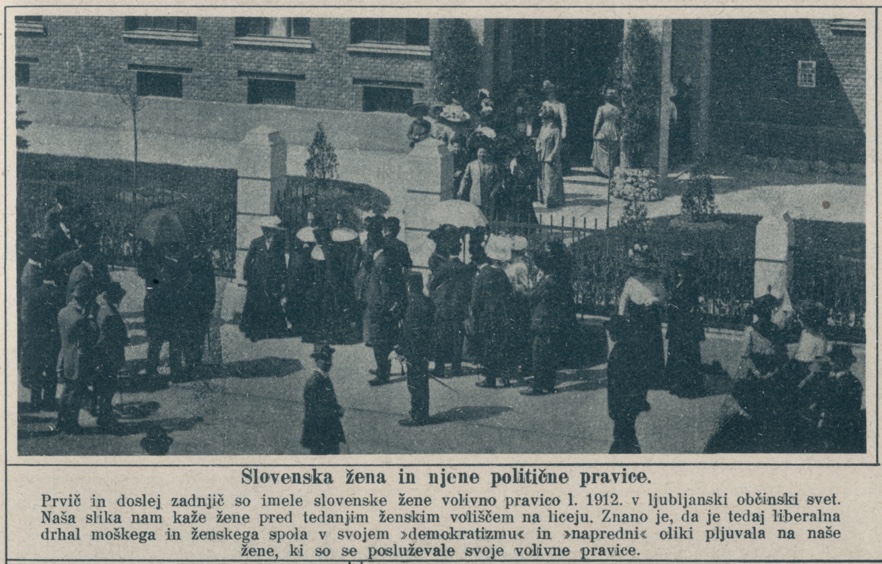
Leta 1911 so lahko ženske na posebnem ženskem volišču v Mladiki prvič osebno oddale svojo volilno glasovnico.
Vir: Ilustrirani Slovenec, 4. 7. 1926. (www.dlib.si)
Morality
The society’s bourgeoisation coincided with the tightening of moral rules and normsy. Advocates for the public morality promoted virtuous living that was to be achieved by internalizing bashfulness. The strict moral norms were in practice often breached in the face of the bourgeois moralists’ requirements. Many Catholic moralists attempted to introduce new virtuous standards also in the countryside and among the working class, attempting to deter them from dancing and consuming alcohol. The bourgeois morality gained prominence particularly in laws regulating sex life. These laws, for instance, limited prostitution, hindered the use of contraception and advertising thereof, often merely with ostensible success. The religious outlook on sexuality gave more and more way to medical interpretations, which in the light of the then morality searched for reasons for sexual deviations (for instance, homosexuality)
in biology.
Katoliški moralisti so v svojih publikacijah obsojali ples, filmske predstave in druge dogodke, ki bi lahko razplamteli strasti.
Vir: A. B. Jeglič, Ženinom in nevestam, 1910.
»Ženin in nevesta? Ali sta bila že kdaj na kaki ženitnini, ali sta se udeležila strastnega, nočnega plesa? Ako sta se, povejta mi, ali ples ni bil skrajno nevaren za lilijo čistosti? Kakšni po- govori so na plesišču? Kake misli, kaki občutki se vzbujajo v plesavcu in plesavki? Ali ni ravno to telesno naslajevanje glavni vzrok, da fant in dekle po plesu tako silno hrepenita? In med plesom? Ali je vedenje vselej sramežljivo, čisto, dostojno? Kaj pa, če se razgret fant in poželjivo dekle izgubita iz društva na samoten kraj, v tamen kot?«
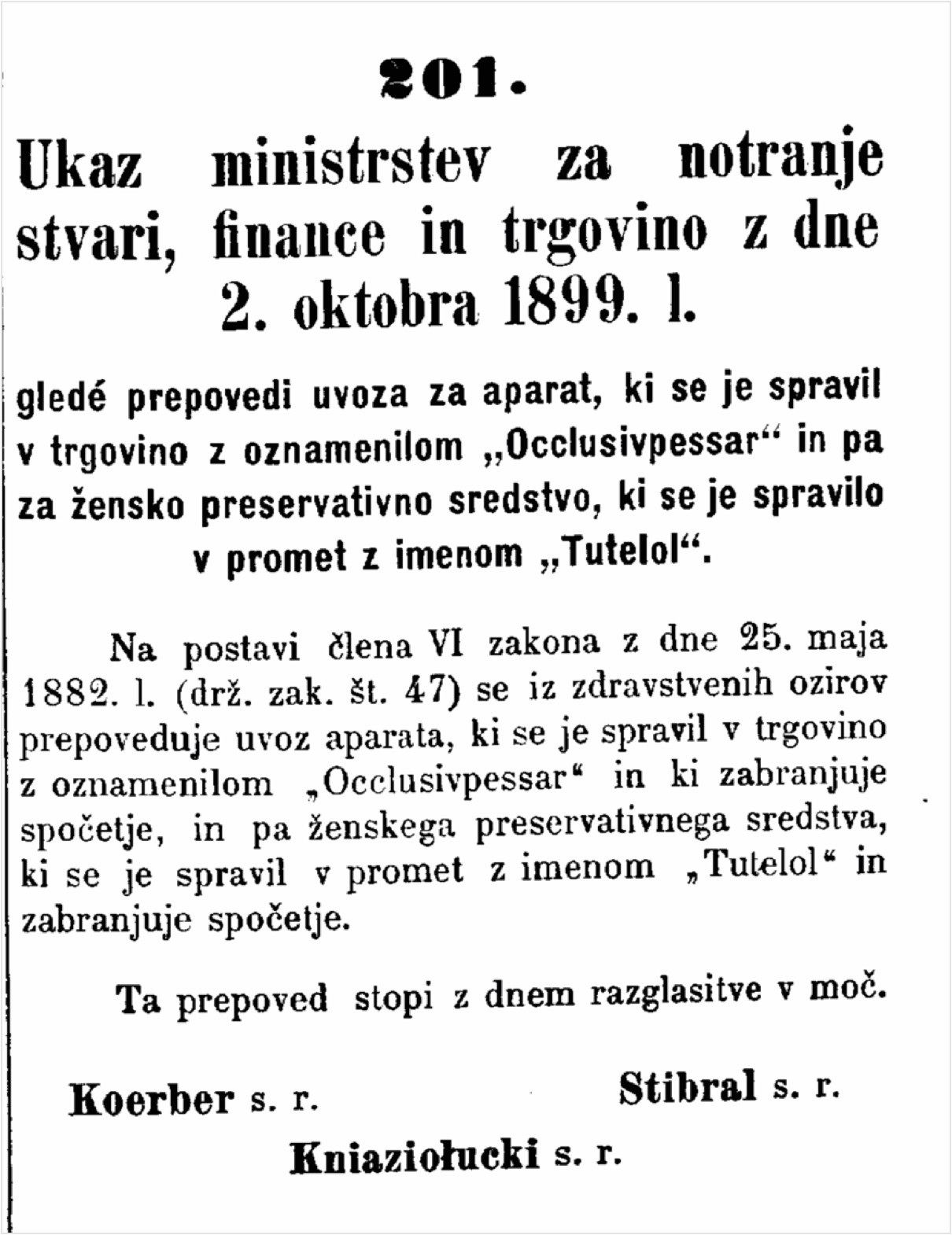
Ministrstvo za notranje zadeve je prepovedalo prodajo zaščitnega sredstva Tutelol in uporabo materničnega vložka Occlusivpessar.
Vir: Uradni list – Reichsgesetzblatt, 1899.
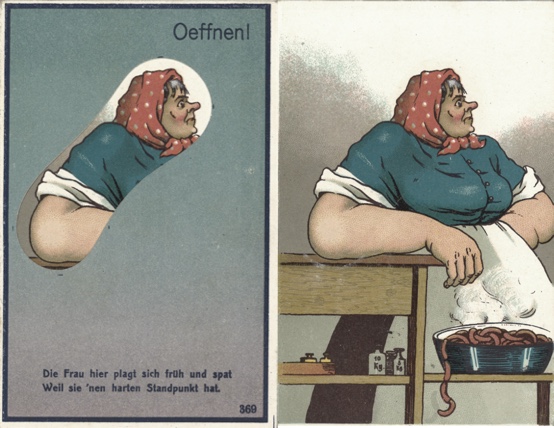
Ženska tukaj se muči prej in kasneje, ker ona nima trdega stališča.
Cenzurirane »nespodobne« razglednice.
Vir: Arhiv Republike Slovenije.
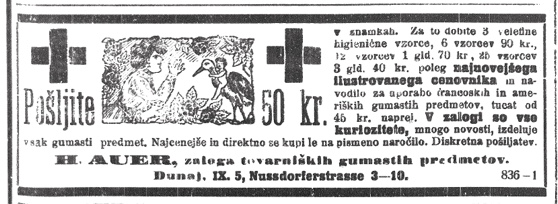
Oglaševanje prodaje kondomov.
Vir: Slovenski narod, 7. 3. 1908. (www.dlib.si)
Birth and Mortality Rate
The birth rate in the territory of present-day Slovenia was still high before World War I; however, like in many other parts of Western and Central Europe, it went into a gradual decline. In 1910, the average number of children born to a woman was 5.2, while in the period 1896–1900 it was 5.6. Considerable differences between individual Slovene provinces and regions were noticeable. The Prekmurje region and the Littoral had the highest birth rate and Carniola the lowest. The fertility rate was higher in the countryside than in cities, where from the second half of the 19th century onwards, where the number of children was deliberately limited particularly by way of coitus interruptus and abortion.
By and large, the mortality rate went into decline before World War I. The maternal death rate and that of newborns remained high. A total of 15.1% of all children aged up to nine months died in Carniola in 1910. The highest infant mortality rate was recorded in cities, particularly among illegitimate children.

Odlomek iz novele avstrijskega Občnega državljanskega zakonika, ki je stopila v veljavo oktobra 1914. Člena 167 in 168 sta vnašala zakonske spremembe, s katerimi se je izboljšal položaj nezakonskih mater in njihovih otrok.
Vir: Cesarski ukaz z dne 12. oktobra 1914, Državni zakonik, št. 154, 13. 10. 1914.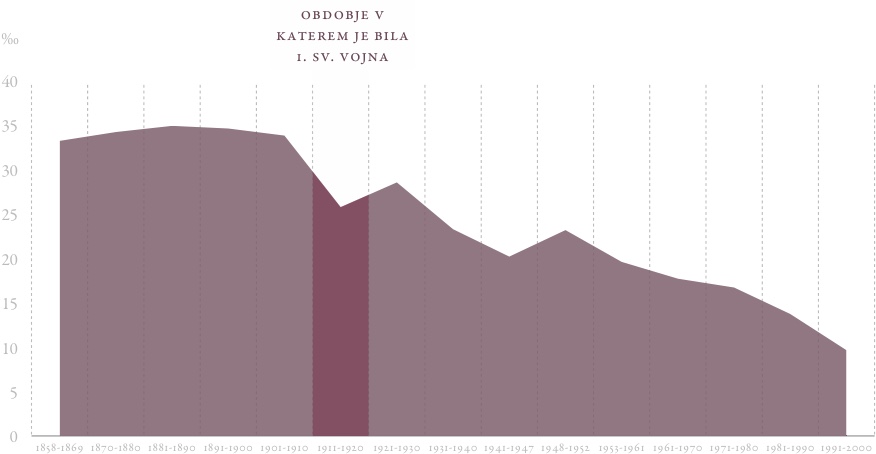
Rodnost na ozemlju današnje Slovenije (1859–2014).
Vir: M. Šircelj, Rodnost v Sloveniji od 18. do 21. stoletja, 2006.
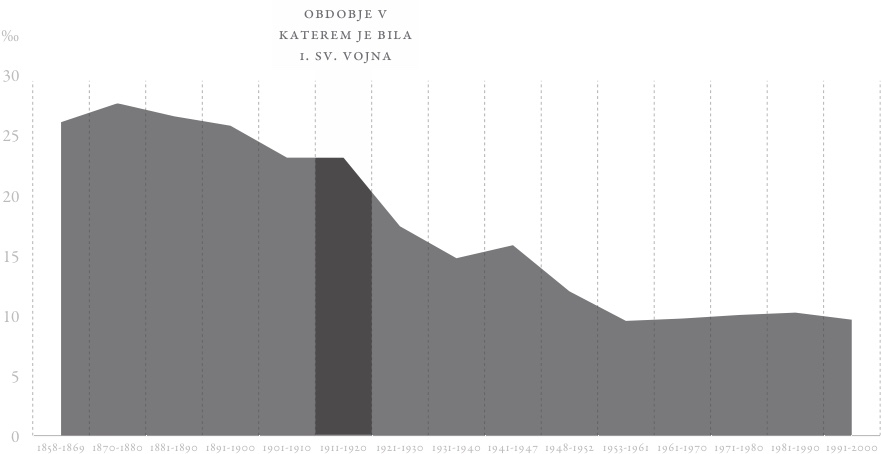
Smrtnost na ozemlju današnje Slovenije (1859–2014).
Vir: M. Šircelj, Rodnost v Sloveniji od 18. do 21. stoletja, 2006.)

Delež nezakonskih rojstev v slovenskih deželah v 19. stoletju.
Vir: S. Ž. Žnidaršič, Ora et labora – in molči, ženska!, 2000.
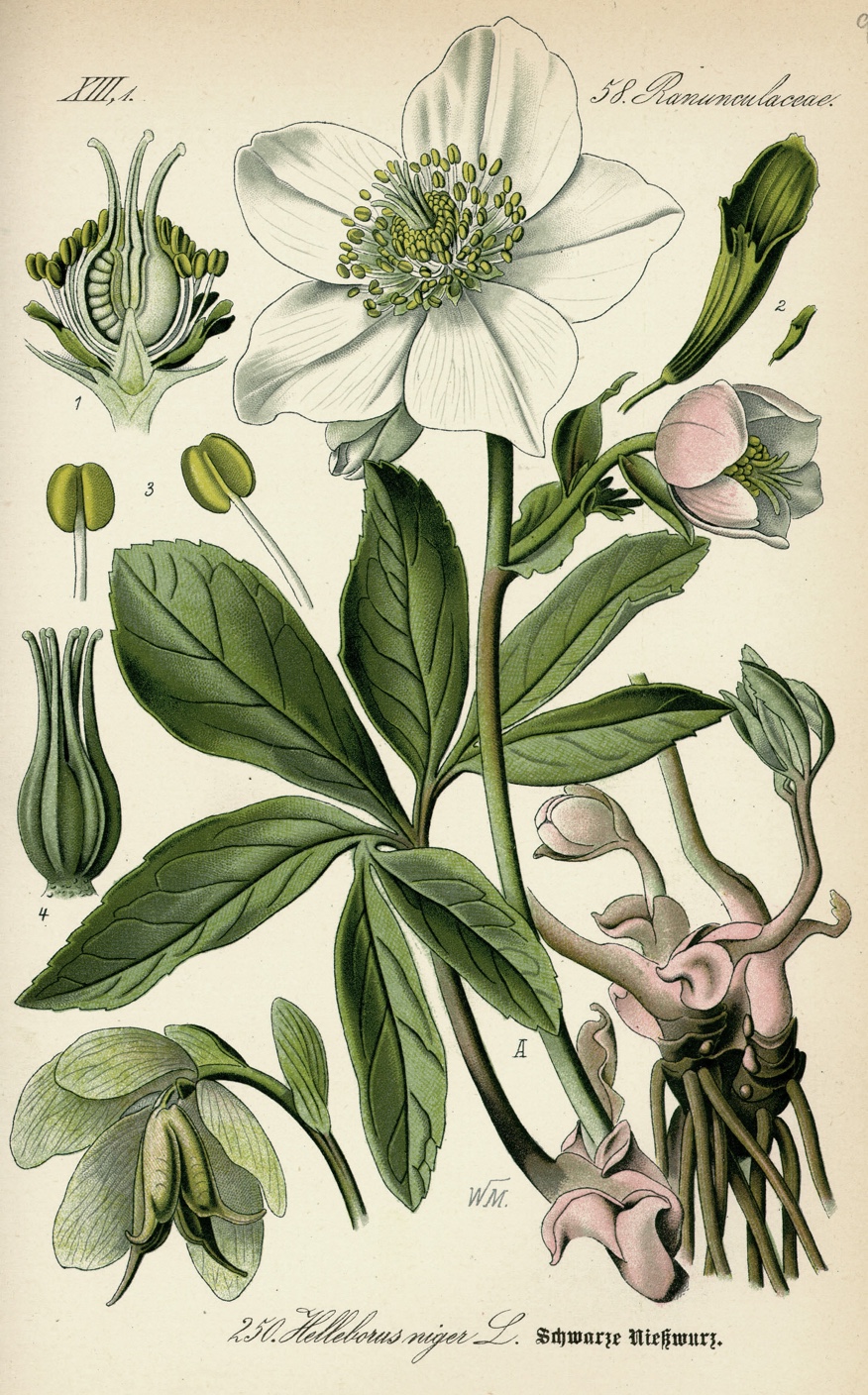
Črni teloh (Hellebrous niger) je bil po Evropi že pred prvo svetovno vojno splošno znan kot abortivno sredstvo.
Vir: wikipedia.org (O. W. Thomé, Flora von Deutschland, Österreich und der Schweiz, 1885)
Caring for Women
and Children
In the 18th and 19th century, Austria introduced a string of measures aimed at the protection of children and improving the position of pregnant women and mothers. Courses for midwives were organized and first Slovene-language midwifery textbooks were published. In 1885, Austria introduced maternity leave in several industries; in 1888, it envisaged maternity allowance within the compulsory health insurance during maternity leave along with other benefits for mothers-to-be. General social protection for the unemployed was in the pre-war period still in its infancy, although soldiers’ families were partly taken care of.
Up to 1887, soldiers’ widows and orphaned children received pensions granted by military institutions or were given alms by the emperor. A new law regulating the provision of family members of conscripted men and fallen soldiers was passed in 1912, on the basis of which within the monarchy soldiers’ wives could apply for financial support already in September 1914.
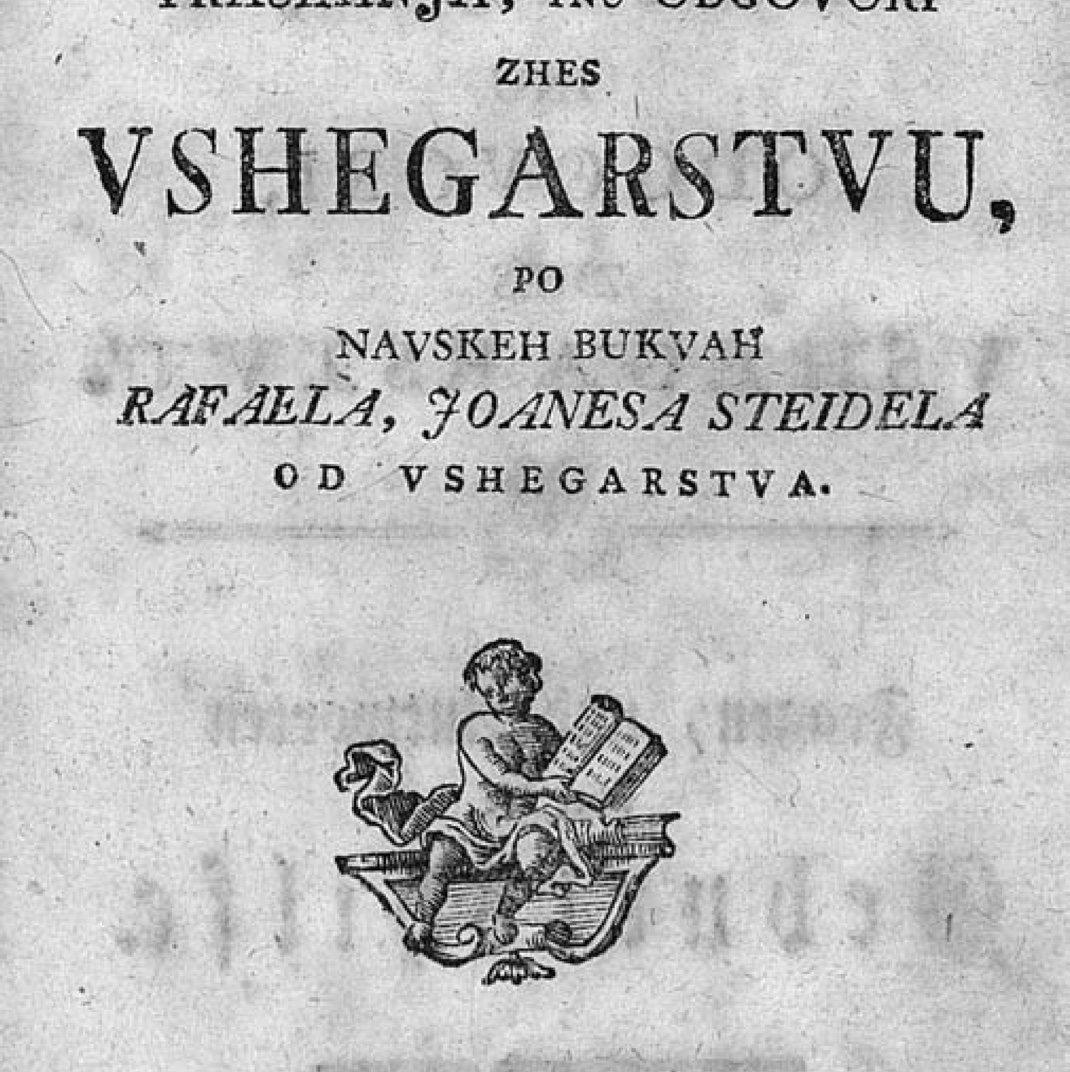
Naslovna stran prvega učbenika za babice v slovenskem jeziku (1782).
Vir: Anton Makoviz, Anton's Makoviz der Zergliederungskunst, Wundarzney, und Geburtshilfe Magisters, und Wundarztes in Laubach, Fragen und Antworten über die Geburtshilfe nach Raphael Johann Steidele's Lehrbuche von der Hebammenkunst, 1782. (www.dlib.si)Dr. Ivan Lah je v knjigi spominov pisal o družinah, ki so ob mobilizaciji sinov, mož ali očetov ostale brez glavnega vira dohodka.
Vir: I. Lah, Knjiga spominov, 1925.
»Sedela sva s tovarišem v mali sobi starega ljubljanskega magistrata v prvem nadstropju. Ura je kazala pol poldne in bilo jih je še mnogo. Tako je bilo dan na dan, odkar se je začela vojna. Pisal sem v oddelku za podporo žen, katerih možje so bili poklicani pod orožje. Prišel sem v ta oddelek tretji dan po začetku vojne. /…/ Pokazalo se je takoj, da se poleg vojne začenja tudi težak notranji boj. Vpoklicani so bili možje delavci, gospodarji, obrtniki – in cela družina je ostala brez dohodkov. Mnogo družin je živelo od tega, kar je koncem tedna prinesel domov oče-gospodar. Sedaj je oče odšel – in beda je zazijala nasproti. Ženske so jokale. Komisija ni mogla vseh prošenj hkrati rešiti, treba je bilo čakati. Prišel je teden in ni bilo niti zaslužka niti podpore. /…/ Kjer je bila družina obilna – je bila tudi vsota precej visoka – in živelo bi se bilo za silo, da ni nastala draginja. Pritožb in težav je bilo dovolj. Nekatere ženske niso mogle dobiti nobenih potrebnih dokazov – in podpora se je zakasnila. Nastalo je vprašanje, kako bo s podporo 'ogarskih državljanov'. Žene brivskih mojstrov so morale zapreti svoje salone in ker so bili brivci večinoma iz 'druge državne polovice', so morale čakati 'nadaljnih ukrepov'. Nova težava je nastala z nezakonskimi materami. /…/ Zgodilo se je, da so dobili podporo ljudje, ki so imeli vsega dovolj – mnogi drugi, ki so bili potrebni, so dobili komaj za prosto življenje. Tako je imel oddelek mnogo dela. V teku treh mesecev sem videl vso vojno od te strani.«
Girls’ Education
In the Habsburg Monarchy women were entitled to primary education, which – particularly towards the end of the 19th century – contributed to a decreased illiteracy rate among women. However, girls were not allowed to continue their education in secondary schools and colleges, with the exception of several trade schools and teachers’ training colleges. In 1896, girls were admitted to the final examination (matura), and, a year later, women who passed the matura were allowed to enrol in the Faculty of Philosophy in Vienna. It was rather late that Austria-Hungary enabled women to matriculate at higher education institutions, 34 years after the University of Zurich, the first European university that allowed the enrolment of women. 27 Slovene women matriculated at the University of Vienna between 1897 and 1918.
At the beginning of the 20th century, university educated Slovene women included Marija Wirgler Jezernik, a pedagogue, Ana Jenko, a chemist, Eleonora Jenko Groyer and Amalija Šimec, who were physicians. Between 1911 and 1915, Klara Kukovec (of Russian descent, married to a Slovene) was the first woman physician in Trieste. Angela Piskernik obtained a PhD in natural sciences in November 1914.

Kako je Eleonora Jenko Groyer (1879–1959) postala prva slovenska zdravnica.
Vir: Iz ženskega sveta, Slovenska gospodinja, 9. 2. 1907. (www.dlib.si)
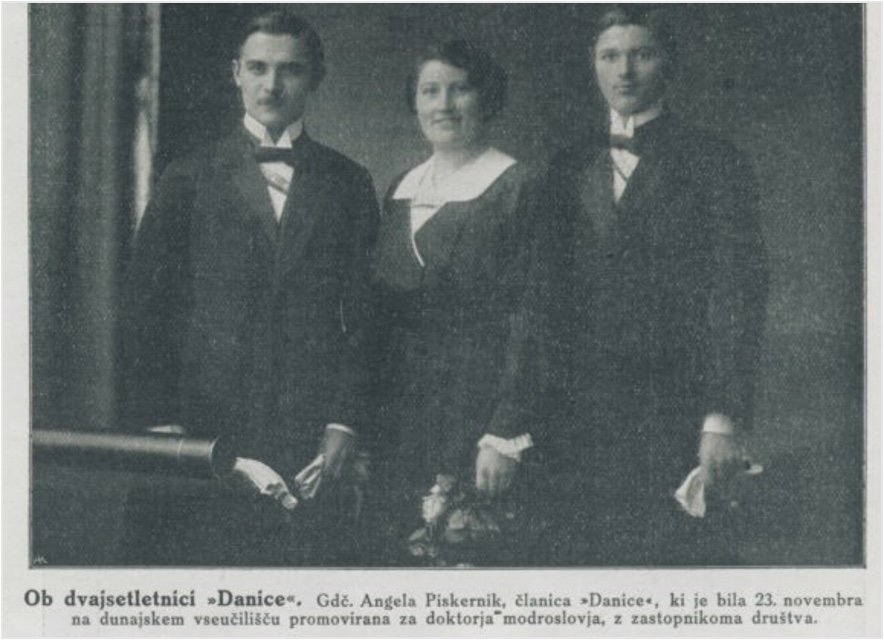
Angela Piskernik (1886–1967) si je po prvi svetovni vojni pridobila sloves prve slovenske znanstvenice.
Vir: Ilustrirani glasnik, 24. 12. 1914. (www.dlib.si)
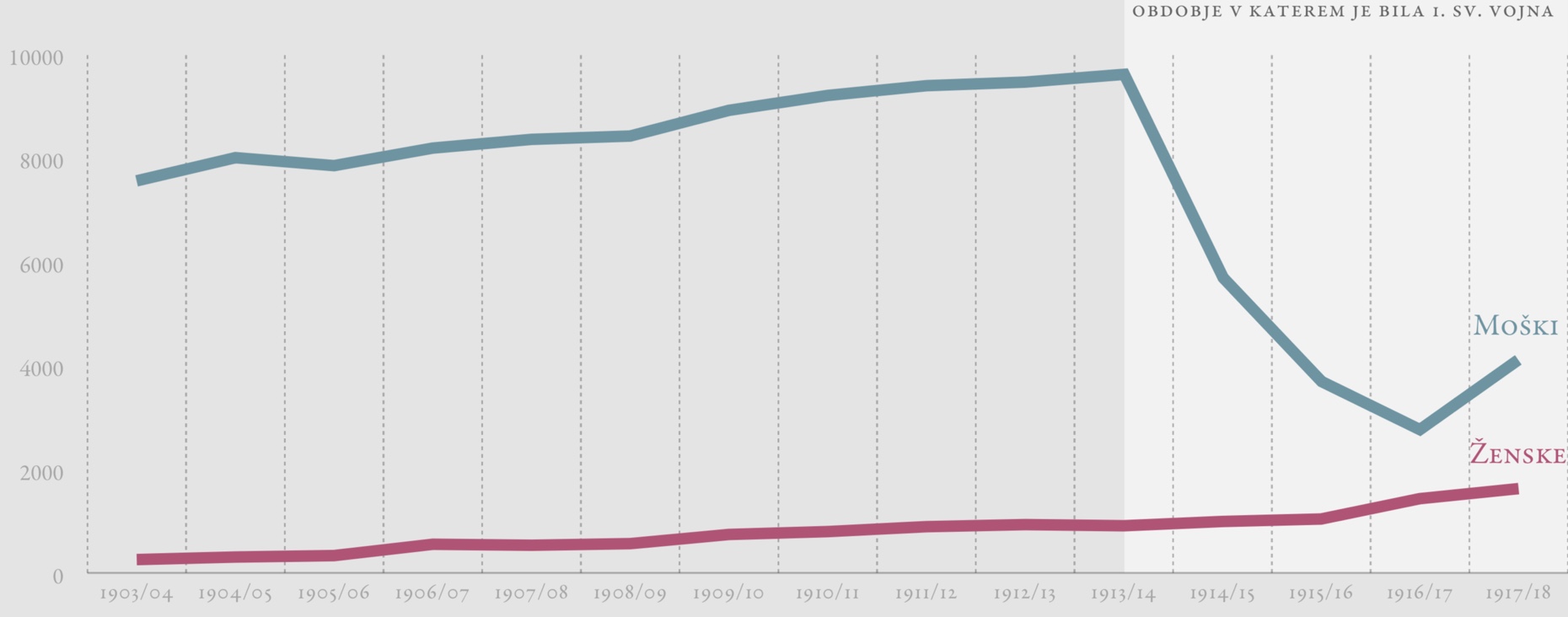
Vpis slovenskih študentk in študentov na dunajski univerzi 1897/98–1917/1918.
Vir: A. Cindrič, Študentke s Kranjske na dunajski univerzi, Zgodovinski časopis, 1/2 (2013).
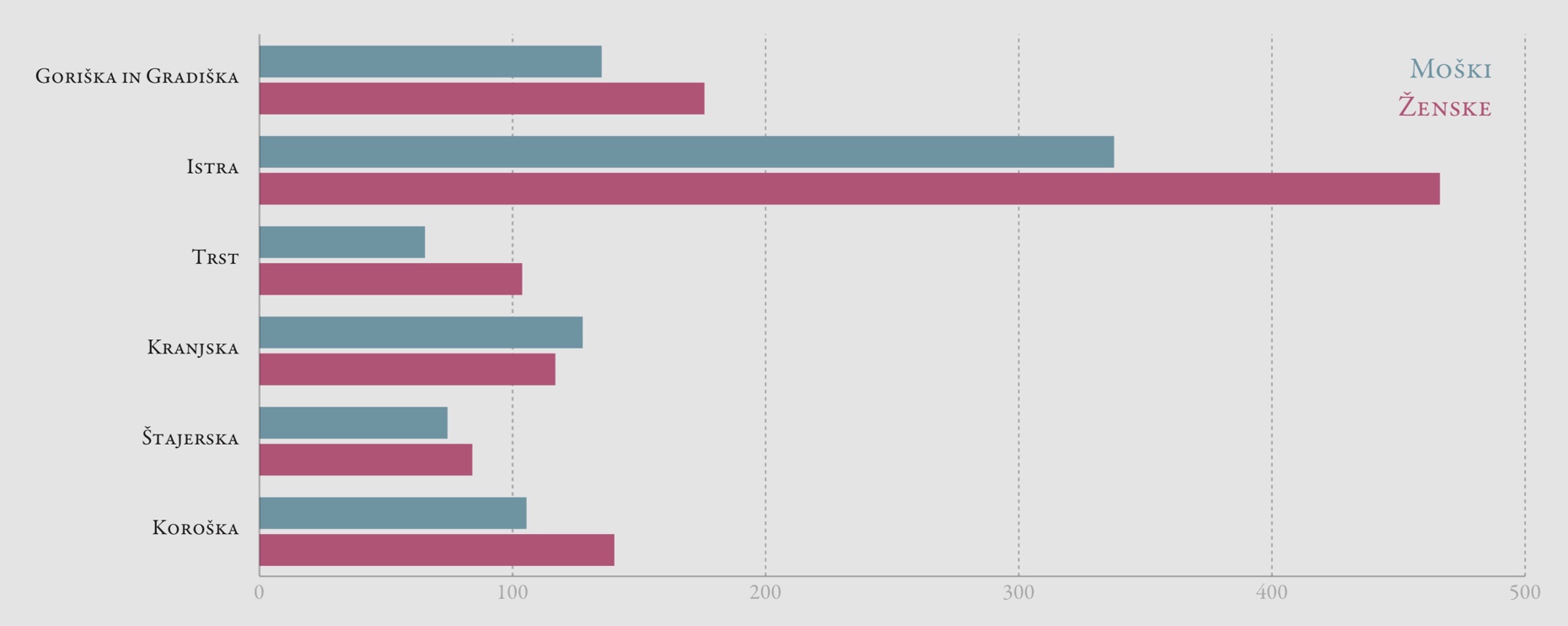
Graf – število nepismenih na 1000 prebivalcev, starejših od deset let (1910).
Vir: Österreichische Statistik (1910), hrani Narodna in univerzitetna knjižnica.
Women’s Associations
Up to 1918 women in Austria-Hungary were not allowed to join political organizations. They were active, first and foremost, in charitable, national defence, and religious societies. Protestant women established the Evangelijsko žensko društvo (Evangelical Women’s Society) in 1856. Catholic societies and, subsequently, labourers’ and teachers’ societies followed suit. The widespread demand for women’s emancipation provided fertile ground for the establishment of emancipatory societies. The “feminist” Splošno slovensko žensko društvo (General Slovene Women’s Society) was established in 1901.
The first independent women’s society in the area of Gorizia and Trieste, the Associazione delle signore a sollievo dei poveri was established in 1869. Throughout the Slovene ethnic territory German women were active particularly in national defence societies: Deutscher Schulverein strove for Germanization of schools and Südmark supported the German colonisation of Slovene territory. In the 1880s, Slovene women started to established branches of Družba sv. Cirila in Metoda (Sts Cyril and Methodius Society) also in the territory along the entire future Isonzo Front.
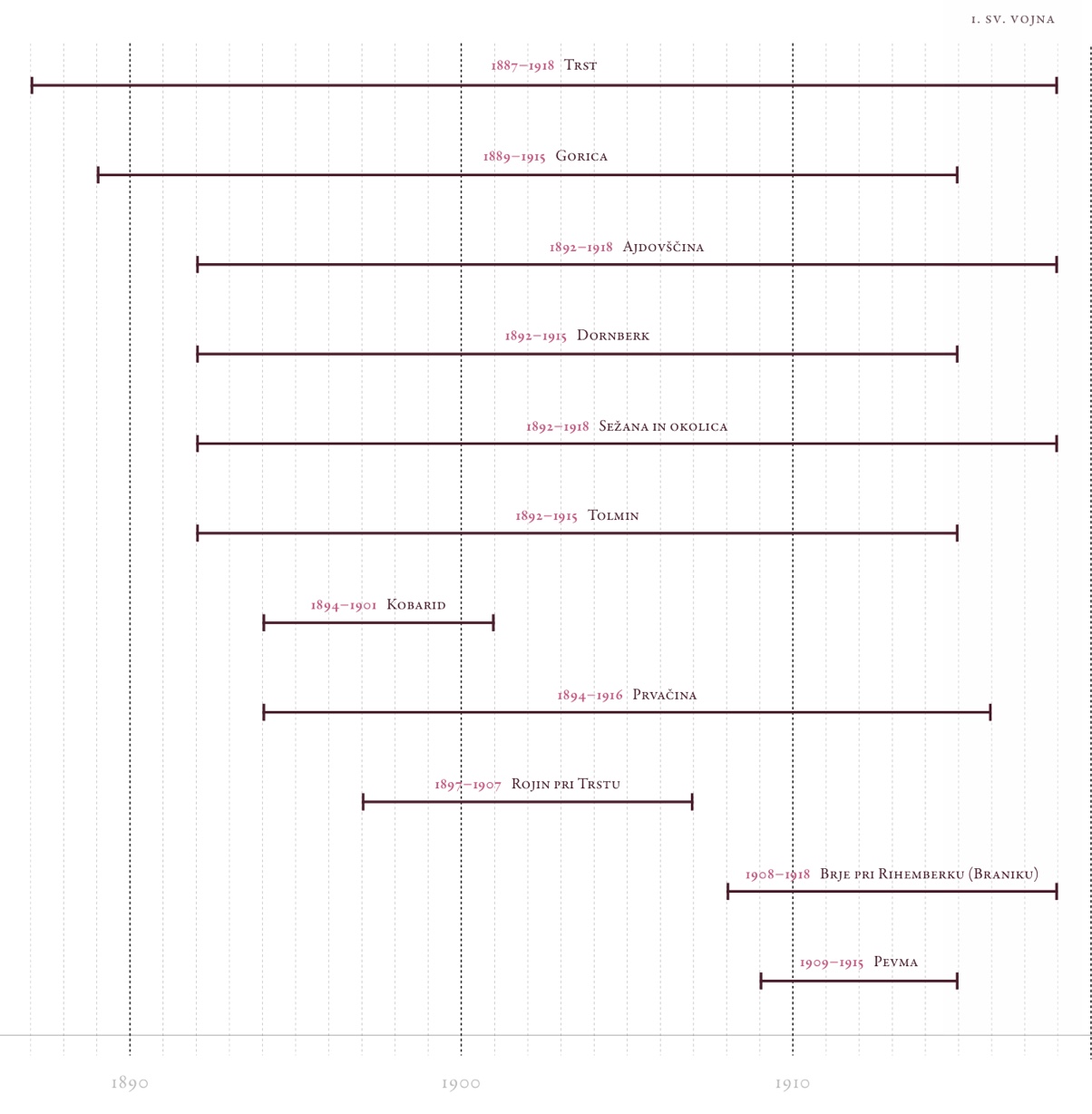
Ženske podružnice Družbe sv. Cirila in Metoda na Goriškem.
Vir: A. Vovko, Odborniki in članstvo podružnic Družbe sv. Cirila in Metoda 1885–1918, 2004.

Leta 1907 je bilo v Gorici prijavljenih šest samostojnih ženskih društev – tri italijanska, dve slovenski in eno nemško. Vsa so nehala delovati leta 1915.
Vir: it.wikipedia.org
Women’s
Periodicals
The first Slovene-language women’s periodical Slovenka (Slovene Woman) was issued in Trieste in 1897. It was edited by Marica Nadlišek, a teacher and author from Trieste. Despite its wide circle of permanent contributors of both genders, it was discontinued in 1902. Its then editor Ivanka Klemenčič-Anžič started working with the central Slovene newspaper Slovenec (Slovene) and became the first Slovene professional woman journalist.
Four women’s periodicals were published in Carniola before the outbreak of the war. Between 1905 and 1914, Slovenska gospodinja (Slovene Housewife) was published as a supplement of the daily newspaper Naš list (Our Paper). Naša gospodinja (Our Housewife) was the women-oriented supplement of Domoljub (Patriot), the newspaper with the largest circulation. Two other periodicals were published for a shorter period of time; namely, Slovenska žena (Slovene Wife) in the years 1912 and 1913, and seven issues of a socialist-oriented monthly periodical Ženski list (Women’s Paper) were published in 1913. Carolina Luzzatto, who edited the newspaper Corriere di Gorizia and became the first woman editor in the Italian-speaking milieu, left her mark on women’s journalism in the Gorizian region.

Mesečnik Ženski list je urejala Alojzija Štebi (1883–1956). Uredništvo je bralkam sporočalo: »Vaše želje, Vaše pravice, Vaše interese bo zagovarjal Ženski list …«.
Vir: Ženski list, 1. 5. 1913. (www.dlib.si)
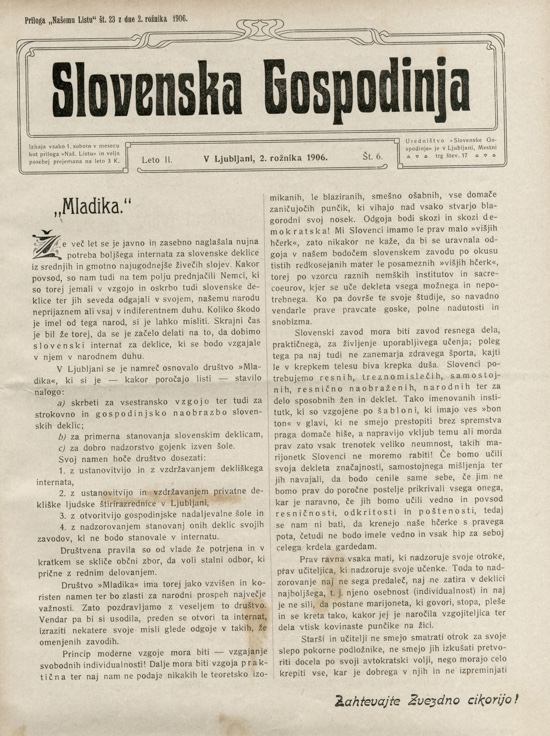
Glavna urednica Slovenske gospodinje je bila Minka Govekar (1874–1950), ena vidnejših osebnosti ženskega gibanja na Slovenskem. Glasilo je poročalo o gospodarstvu ter domačih izdelkih in podjetjih.
Vir: Slovenska gospodinja, 2. 6. 1914. (www.dlib.si)
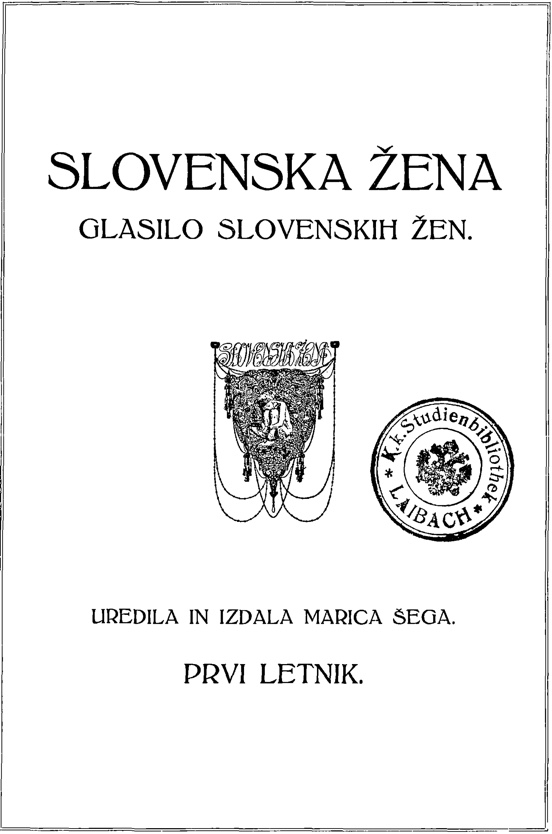
Glasilo Slovenska žena je urejal in izdajal Rudolf Šega (1880–1934), ki je pri tem uporabljal ime svoje žene Marice. Glasilo je imelo izrazito družbeno-politično noto, obravnavalo je tudi teme iz gospodinjstva in vsakdanjega življenja.
Vir: Slovenska žena, 1914. (www.dlib.si)
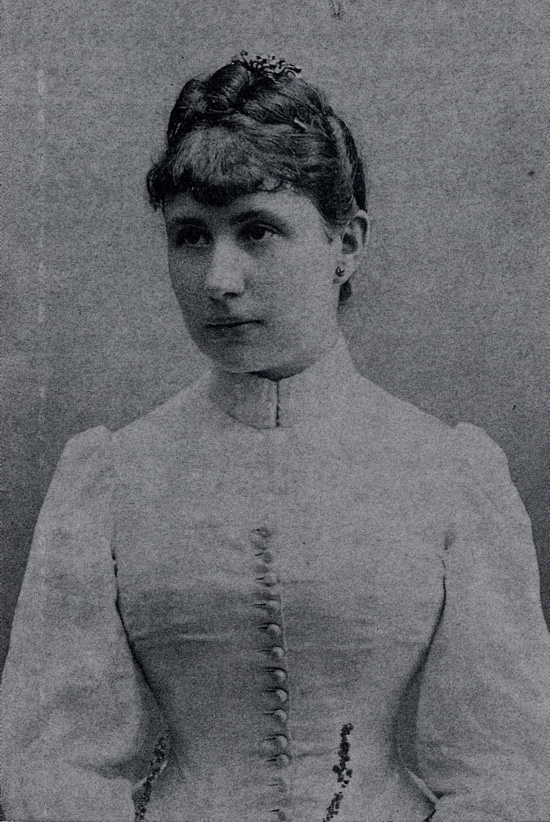
Carolina Luzzato (1837–1919) je pisala za mnoge osrednje severnoitalijanske časopise. Rodila se je v tržaški judovski družini in postala vidna italijanska iredentistka. Med vojno so jo obtožili vohunstva in zaprli v avstrijsko kaznilnico Göllersdorf, kasneje pa še v Oberhollabrunn.
Vir: L. Fabi, Storia di Gorizia, 1991.
Women’s
Labour Market
According to the population census of 1910, two thirds of the population in the territory of present-day Slovenia were peasants, and 11% of the population was employed by the industry or trade. A lengthy agrarian crisis, the fragmentation of land, and the unemployment rate expedited emigration that peaked in the decade preceding the Great War. In families in which men left the country in search of employment abroad, women were often in charge of the family economy.
About 30,000 boys and men were recruited in the general conscription in July and August 1914. Initially, their conscription did not change the conditions in the labour market. The period saw an increased demand for items, particularly footwear, clothing, foodstuffs, and tobacco products, which were manufactured by factories and workshops employing women. The outbreak of the war brought women’s emigration to a halt. For instance, traffic connections with Egypt were disrupted, which prevented “Alexandrian women” from returning home and sending their earnings to their families.
Vir: Slovenski narod, 30. 7. 1914. (www.dlib.si)
»Uradne ure pri Mestni hranilnici ljubljanski so za stranke odprte samo od 8. do 12. dopoldne, ker je preveč uradnikov vpoklicanih v vojake.«
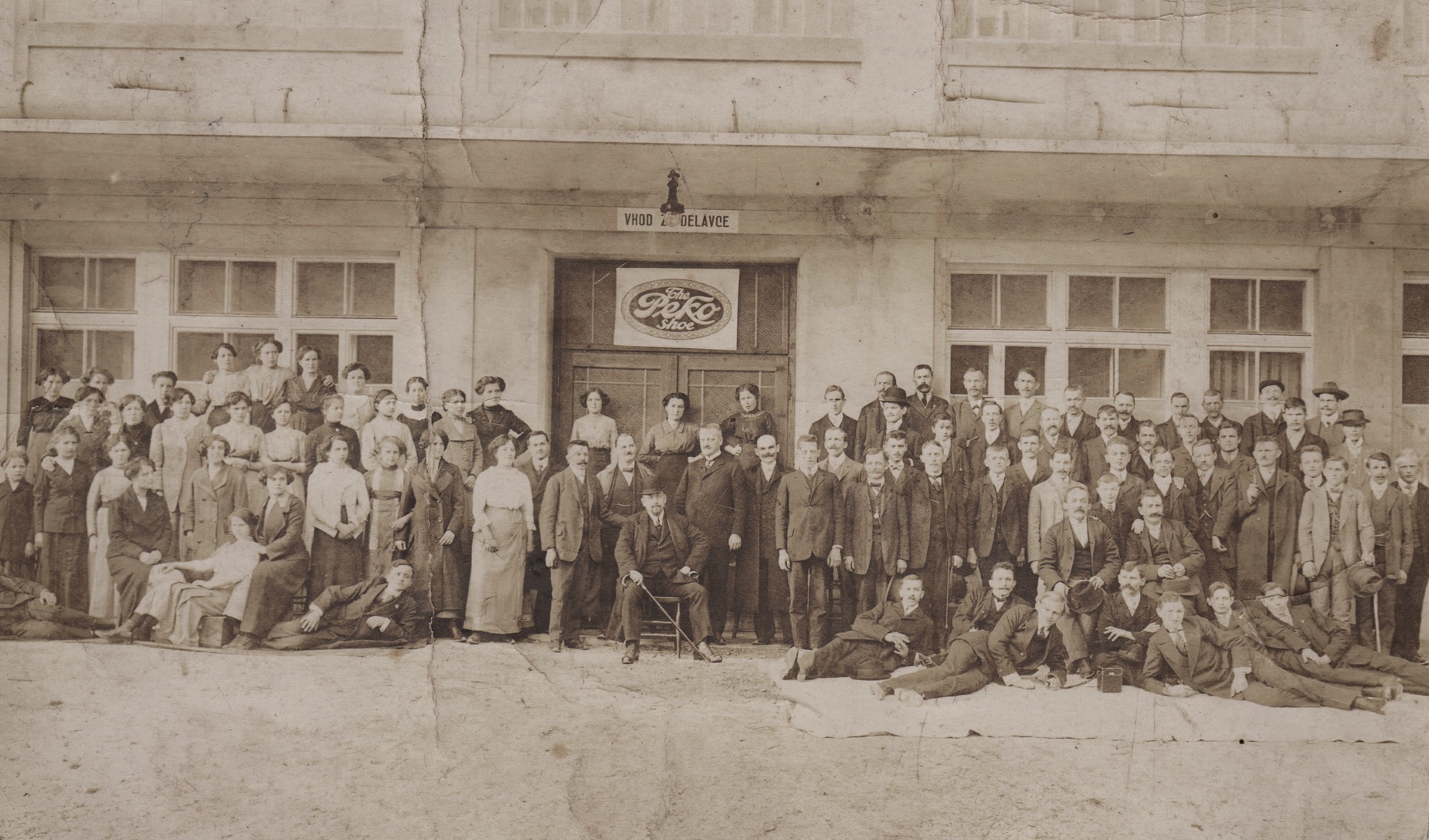
Lokalni čevljarski obrati, kot je bil tržiški Peko, so kmalu po izbruhu vojne dobivali večja naročila vojaških čevljev.
Vir: Arhiv Tržiškega muzeja.
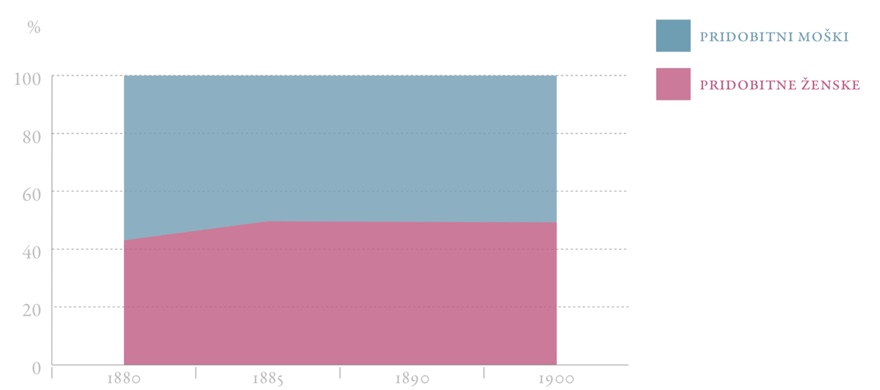
Pridobitnost žensk je pred prvo svetovno vojno narasla.
Vir: S. Ž. Žnidaršič, Ženske na trgu dela: čas sprememb 1880–1910, Prispevki za novejšo zgodovino, 2003.
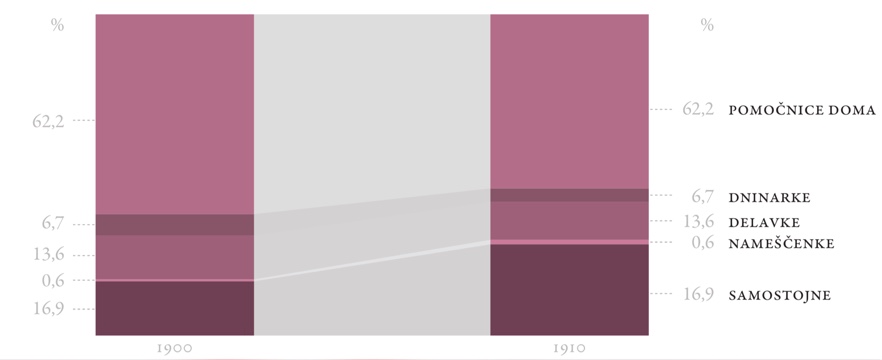
Razporejenost žensk po posameznih pridobitnih statusih (v %).
Nursing
Auxiliaries
In the countryside, individual charity societies and organisations (The Red Cross, St Vincent Society) organized training courses for nursing auxiliaries already before World War I. Namely, this type of personnel, the majority of whom consisted of nuns working in individual hospitals throughout Carniola, was scarce. St Vincent Society started training them already in 1912, and the Red Cross followed suit a year later. Nursing auxiliary candidates had to be 25 to 35 years of age, unmarried, “morally irreproachable”, and in good physical shape. Having completed their training, they became nursing auxiliaries; since they were not nuns, they were also referred to as secular nursing auxiliaries. A regular nursing school was planned by the Carniolan authorities; however, its establishment was prevented by the outbreak of World War I.
Food Provision
Austria-Hungary entered the war with insufficient reserves of food and raw materials. The price of foodstuffs had increased already before the outbreak of the war; due to shortages the central authorities imposed a price cap on foodstuffs in mid 1914. An increased demand for food for the army and the civilian population led to the development and an expedited production of food industry, which employed mostly women.
During wartime, the supply of foodstuffs was a priority concern for municipal authorities; meanwhile, the rural population had to rely on its own ingenuity and possibilities at hand. Owing to the paralysing of civilian and social institutions the increasingly difficult provision was alleviated also by women and children, who gathered various materials (clothing, gold, stores for the winter, etc.) for the army and the war-related industry. Due to the general mobilization, which took place from 31 July 1914 onwards, women took care of the rich harvest. They were helped by children, young people, the old, and by men unfit for military service.
Spomin na predvojno blaginjo in obilje mize v zapisih Doberdobčanke Jožefe Jarc Lakovič predstavlja protiutež stopnjujočemu se vojnemu pomanjkanju.
Vir: M. Verginella, Velika vojna med spominom in pozabo, Soška fronta 1915–1917: kultura spominjanja, 2010.
»Začelo se je živeti bolje: dovolj je bilo polente in kruha, v nedeljah se je jedlo meso. Enkrat letno se je klalo prašiča in doma smo imeli slanino.«
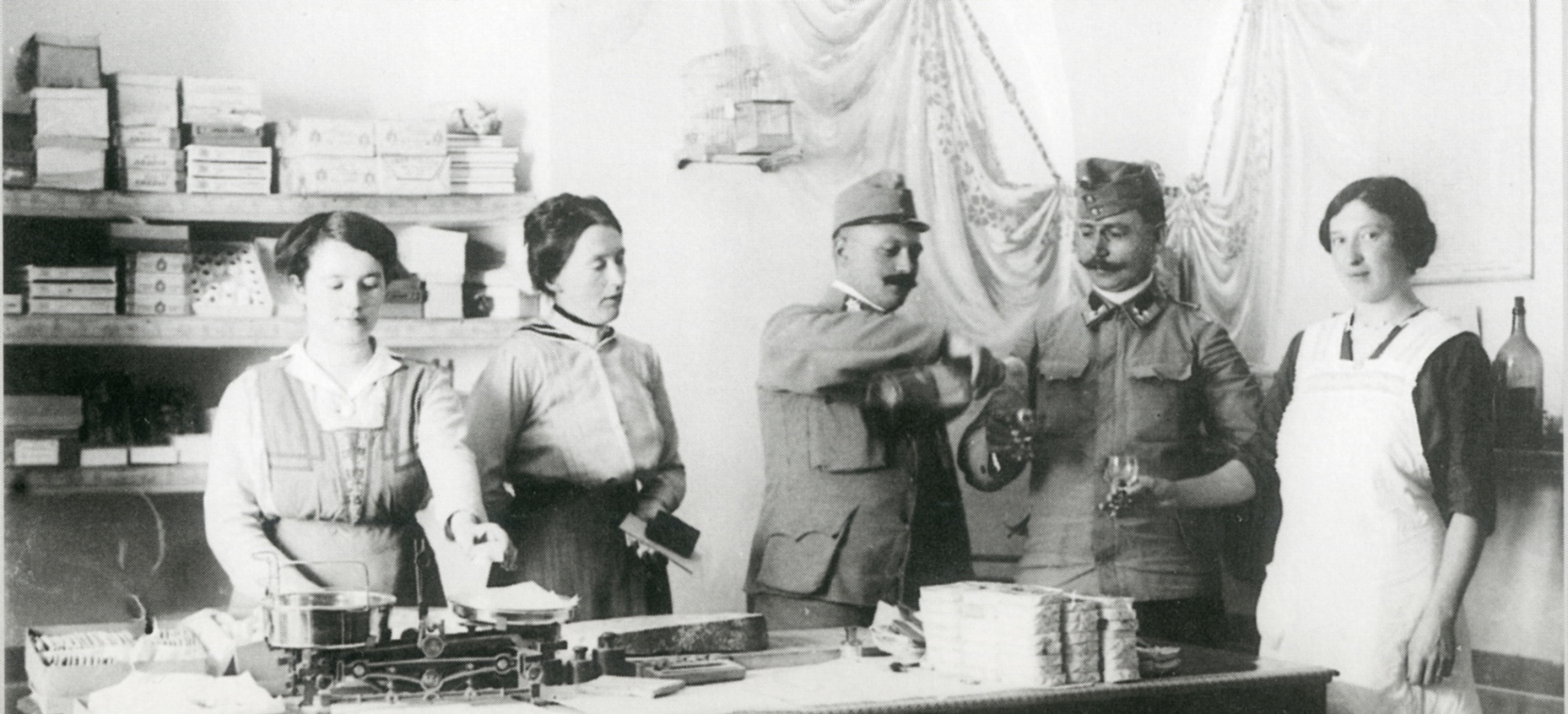
Vojaška kantina na Ljubljanskem gradu; ženske so bile pomembne tudi pri pripravi hrane za vojsko.
Vir: P. Naglič, Moji spomini na svetovno vojno, 2007.
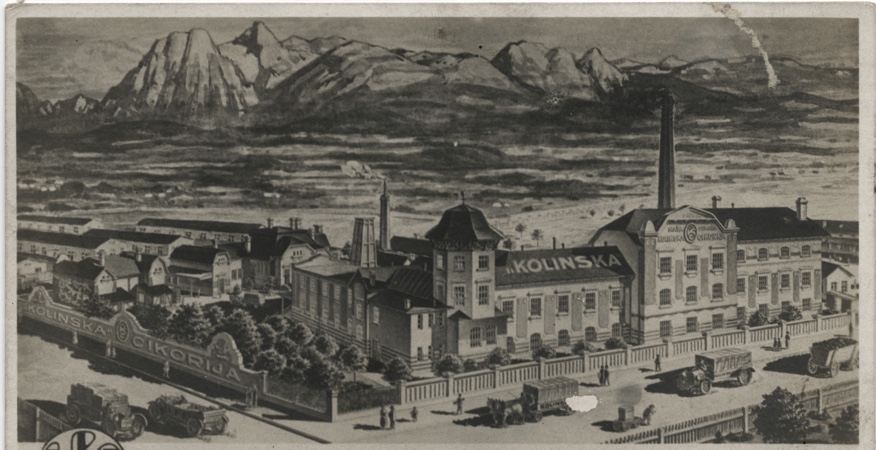
Ljubljanska izpostava češkega podjetja Kolinska, proizvajalka kavnih nadomestkov, je sodelovala pri oskrbovanju vojske s hrano. Ženske so bile v proizvodnji Kolinske množično zastopane.
Vir: Fototeka Zgodovinskega arhiva Ljubljana.
Refugees
Upon the outbreak of combat in Galicia and Bukovina (present-day Ukraine, Poland, and Rumania) in September 1914, the Austro-Hungarian authorities uprooted the local civilian population. A swift evacuation brought about chaotic migrations and break-ups of many families. A smaller portion of this first refugee wave, particularly Ruthenian and Polish families with a considerable share of women and children, settled in Slovene regions, mostly in the countryside, where they worked in exchange for meagre wage, food, and lodgings. Women refugees staying in cities and refugee camps often helped out in military medical institutions.
Under the law of August 1914, the authorities had to cover the cost for refugees’ food, clothes, health, cultural and religious needs, which was not always the case. On numerous occasions the refugees were faced with the locals’ aversion, which was after the outbreak of the Isonzo Front experienced also by refugees from the Soča region.
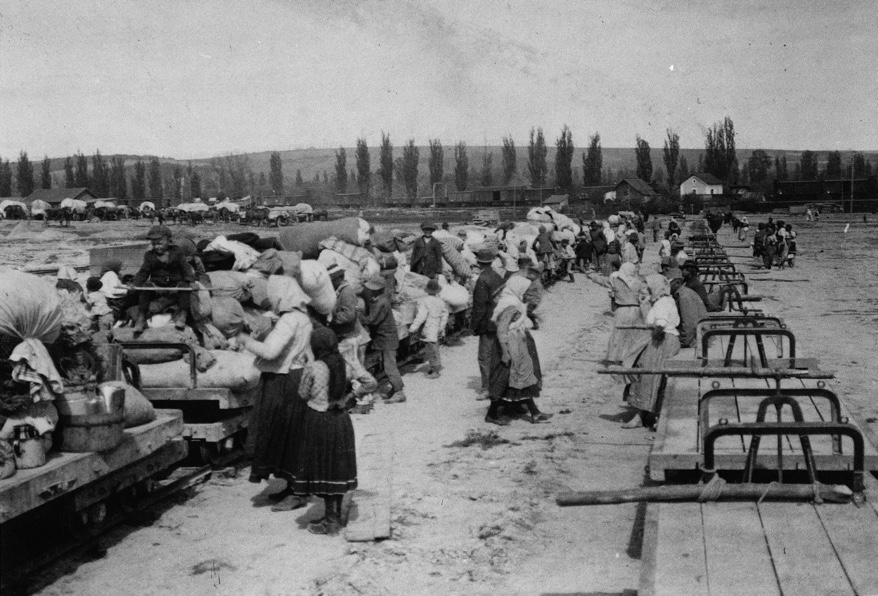
Galicijski begunci dajejo svoje imetje na železniške vagone.
Vir: Muzej novejše zgodovine Slovenije.
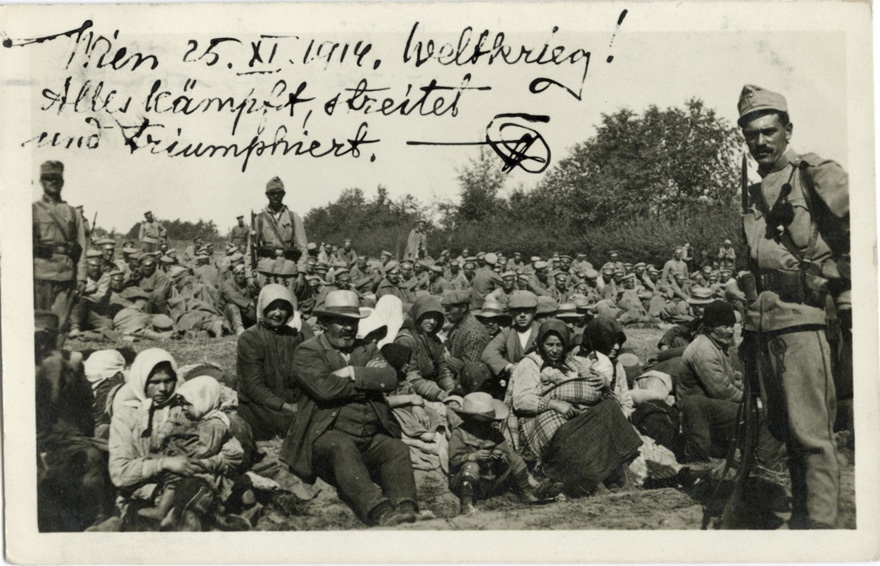
Razglednica poslana novembra 1914 z Dunaja v Tržič. Galicijski begunci in vojni ujetniki iz vzhodne fronte.
Vir: Muzej novejše zgodovine Slovenije.

Galicijska begunska družina v Homcu pri Domžalah.
Vir: P. Naglič, Moje življenje v svetovni vojni, 2007.
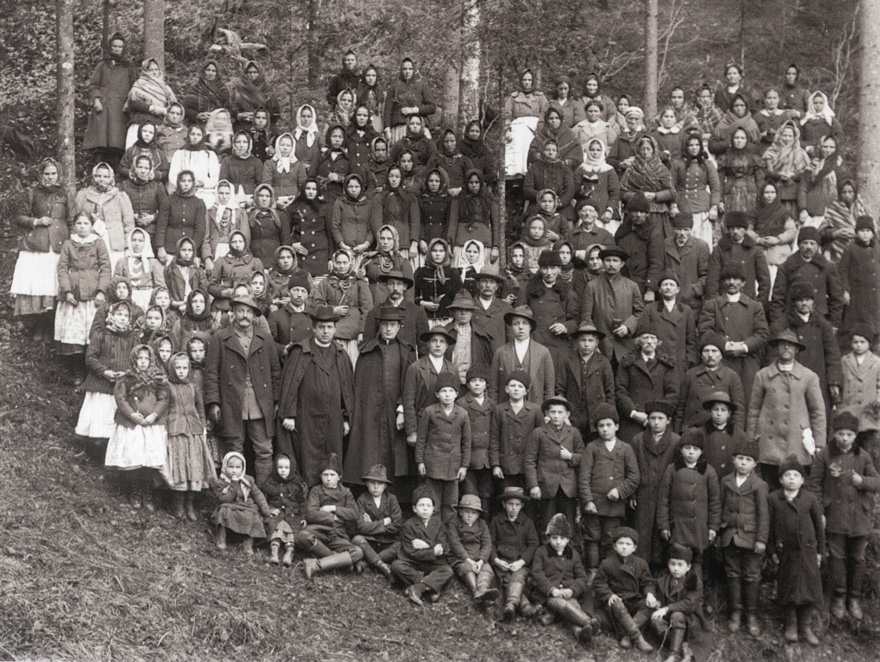
Galicijski begunci, uniati po veroizpovedi, na Holmcu pri Domžalah: otroci, starejši moški in ženske.
Vir: P. Naglič, Moje življenje v svetovni vojni, 2007.
»Plača se mi je takoj za tretjino zmanjšala, cene živil so zrasle. Vladala je panika. Ljudje so verjeli, da bi jih lahko izstradali in so brezglavo kupovali na zalogo. Tudi jaz sem si kupila sveženj sveč, da bi vedno imela svetlobo. Ljudje so drug drugemu trgali iz rok dnevni časopis.«
Alma Karlin
Responses to the Assassination and
the Beginning of the War
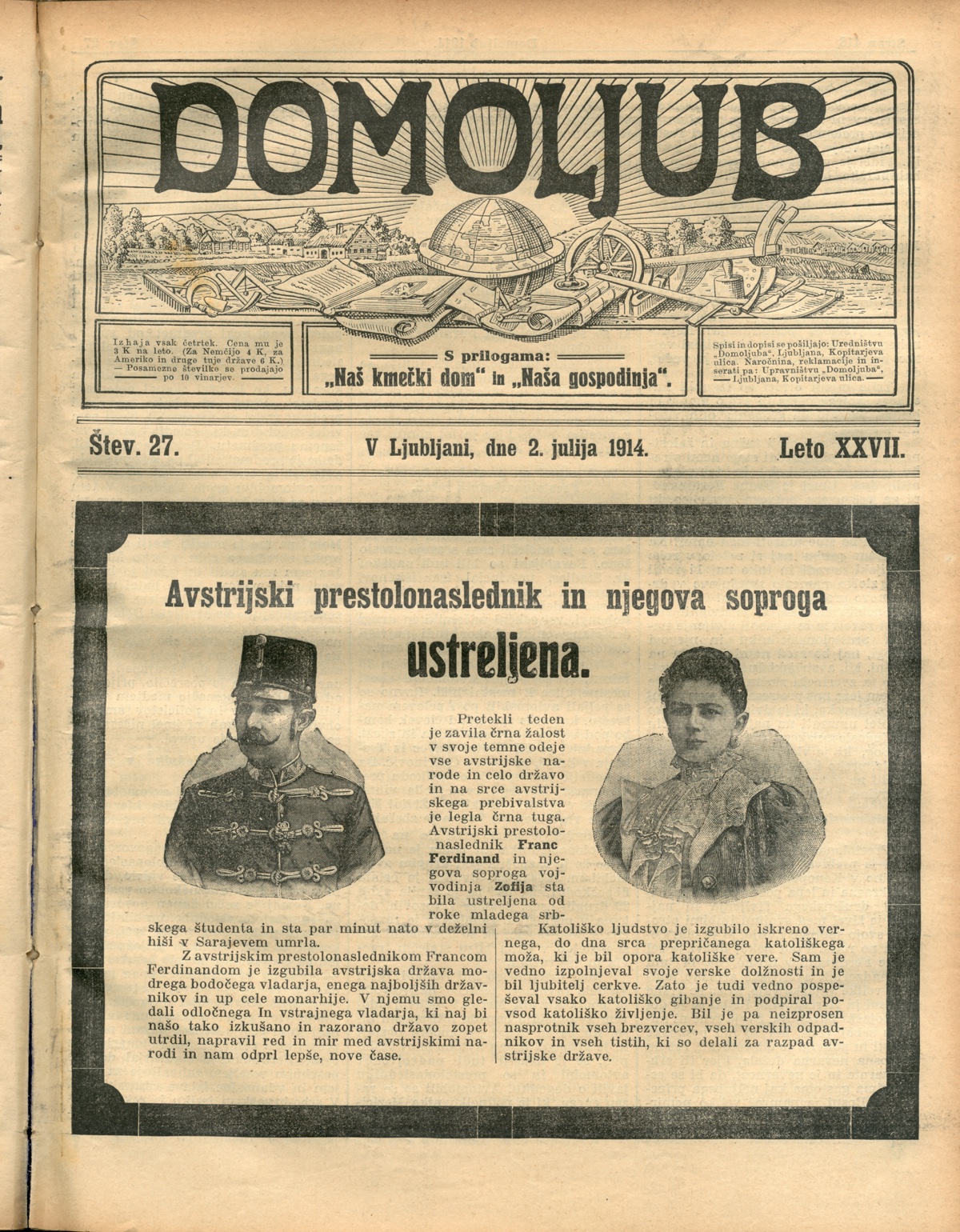
For the most part, the Slovene press supported to the official Austrian war policy. It was appalled by the assassination in Sarajevo and supported Austria-Hungary’s declaration of war to Serbia. As a rule, opinions that opposed the declaration of war remained on the public’s margins. The conflict was supported by women as well. Similarly to other related societies throughout Europe, Austrian women’s societies abandoned their pacifist beliefs and broke off international contacts. Women got involved in preparations for the war on the so-called “internal front”, some of them hoping that their efforts would contribute to the recognition of their civil rights. Helmed by Franja Tavčar, Slovene “national ladies” were also quick to respond to the mobilization. They organised a “ladies’ committee” that gathered food and clothing for soldiers.
Not all Slovene women were enthralled by the declaration of war. In private, some of them were either concerned about their loved ones leaving for the front or displeased due to the war’s material consequences in the hinterland. In the face of the strict censorship some of them were openly opposed to the process of militarization and made fun on the assassinated heir to the throne. The Austrian authorities suspected individual women of spying for the enemy, of wartime financial support frauds, or of helping deserters, which was punishable by imprisonment or internment.
»Tistega razgibanega julija so odpovedali vsi. V glavah so imeli najbolj pustolovske predstave o modernem vojskovanju, precenjevali in podcenjevali so tisto, kar še niso nikoli preizkusili; niso slutili niti kako dolgo bo trajal spopad niti koliko trpljenja bo povzročil.«
Alma Karlin
Odlomek iz pisma Vladimire Jelovšek mami, Zofki Kveder, odposlano 6. 10. 1914.
Vir: Rokopisni oddelek Narodne in univerzitetne knjižnice.
"Ne moj misliti, da vlada samo u Zagrebu potištenost. Ovdje se svi boje glada i kolere. Čitala si već sigurno, da je u Idriji i Litiji kolera, dakleće uskor doći i u Ljubljanu /…/ kolere ranjenci, sa sjevernog bojišta u takvom stanju, da je to teško opisati. Sada če biti opet pozvani od 18–60 g, te će se morati valjda sva škole izprazniti. Da bi bio već barem konac svega toga."
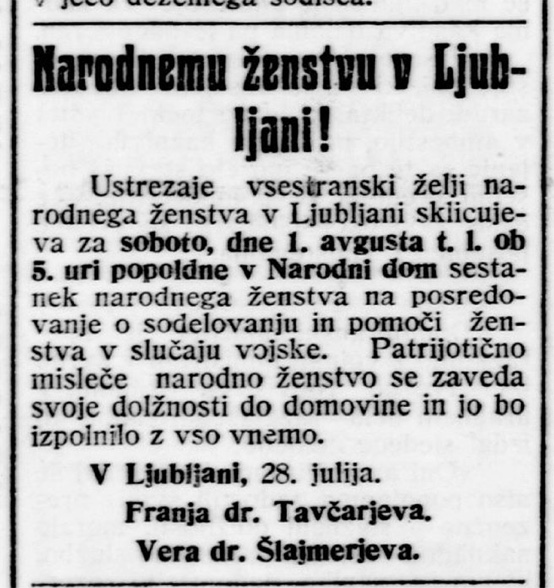
Franja Tavčar in Vera Šlajmer napovedujeta sestanek o sodelovanju slovenskih žensk v vojni (28. 7. 1914).
Vir: Narodnemu ženstvu v Ljubljani!, Slovenski narod, 28. 7. 1914. (www.dlib.si)
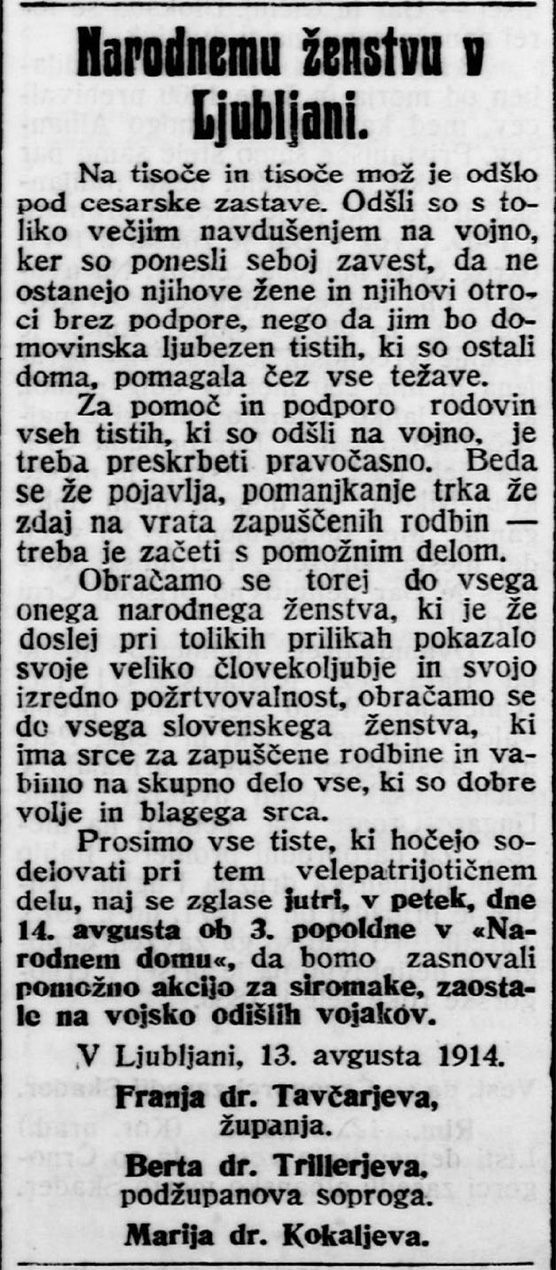
Organizirano ženstvo s Franjo Tavčar, Berto Triller in Marijo Kokalj, ki agitira za pomoč revežem avgusta 1914.
Vir: Slovenski narod, 13. 8. 1914. (www.dlib.si)

»Damski komité« zbira hrano za bolne in ranjene vojake.
Vir: Učiteljski tovariš, 11. 9. 1914. (www.dlib.si)






